652 Case Study Topics & Good Ideas
- Icon Calendar 18 January 2024
- Icon Page 5518 words
- Icon Clock 25 min read
Case study topics delve into intricate issues within various fields, shedding light on the intricacies of real-world situations. They span multiple domains, including business, where they may explore strategic decision-making strategies, or healthcare, examining patient outcomes in unique cases. In technology, they may dissect software development practices or the impact of artificial intelligence (AI) on society. For education, case studies may scrutinize pedagogical approaches and their effects on student performance. In the social sciences, they can unpack complex societal phenomena or individual behavior. Each topic is an author’s microscope, providing an in-depth, multi-faceted perspective of its subject matter. By studying these topics, researchers and students alike can gain valuable insights into the practical implications and consequences of theories and principles, bridging the gap between abstract ideas and their tangible manifestations in the world.

Hot Case Study Topics
- Facebook’s Data Privacy Controversy: A Deep Dive
- Amazon’s Dominance: Exploring Market Strategies
- Global Response to COVID-19: A Comparative Analysis
- Tesla’s Disruption of the Auto Industry: A Case Study
- Implementing Agile Practices: A Spotify Case Study
- Alibaba’s Expansion Into International Markets
- Apple’s Innovation Strategy: Maintaining a Competitive Edge
- Starbucks: Mastering the Art of Customer Experience
- Netflix: Redefining Television and Film Distribution
- IKEA’s Global Branding and Localization Strategies
- Mental Health Services: Evaluating Teletherapy Platforms
- WeWork’s Rapid Rise and Fall: Lessons Learned
- Economic Impact of Brexit: A Sectoral Analysis
- Exploring Uber’s Gig Economy Business Model
- Zoom’s Growth During the COVID-19 Pandemic
- Sustainable Practices: A Patagonia Case Study
- Disaster Management: Lessons From the Fukushima Nuclear Accident
- Airbnb’s Impact on the Traditional Hospitality Industry
- Google’s Algorithm Updates: Understanding SEO Impacts
- CSR Initiatives: A Coca-Cola Case Study

Simple Case Study Topics
- Small Business Success: A Local Bakery Case Study
- Community Engagement: Park Revitalization Project
- Efficiency in Nonprofit Organizations: A Food Bank Case Study
- Art Therapy and Mental Health: A Clinical Case Study
- Managing School Bullying: Strategies and Outcomes
- Green Initiatives: Local Recycling Program Case Study
- Exploring E-Learning: A Virtual Classroom Case Study
- Music and Memory: A Case Study in Dementia Care
- Animal Assisted Therapy: A Case Study in Child Psychology
- Internet Safety Education: School Implementation Case Study
- Outdoor Education: A Forest School Case Study
- Meal Planning Apps: A User Experience Case Study
- Teenagers and Social Media: A Behavior Study
- Urban Farming: A Case Study in Sustainable Living
- Book Clubs and Literacy: A Community Library Case Study
- Elderly Care: Home vs. Assisted Living Facilities
- Supporting Autistic Students: A Special Education Case Study
- Reducing Plastic Waste: A Supermarket Initiative Case Study
- Stress Management at Work: A Corporate Wellness Program Case Study
- Yoga and Wellness: A Community Center Case Study
Interesting Case Study Topics
- Vanishing Bees: An Ecological Case Study
- Cryptocurrency’s Influence on Traditional Banking
- Medical Miracles: A Case Study of Extraordinary Recoveries
- The Resurrection of Vinyl: A Case Study in Niche Markets
- Rebirth of Drive-In Theaters Amidst Pandemic
- Mars Rover Missions: A Case Study in Robotic Exploration
- Feral Children and Human Behavior: An Ethnographic Case Study
- Forensic Science in Action: High-Profile Criminal Cases
- Haunted Tourism: A Business Case Study
- Ethics of Artificial Intelligence: Industry Examples
- Recovery of the Ozone Layer: A Global Effort Case Study
- Graffiti as Urban Art: A Cultural Case Study
- Preservation of Endangered Languages: Case Studies
- Crowdfunding Success Stories: An Economic Case Study
- Pseudoscience in Marketing: A Consumer Case Study
- Augmented Reality in Education: Exploratory Case Study
- Internet Memes and Virality: A Social Media Case Study
- Revival of Dying Crafts: A Case Study in Cultural Preservation
- Language Development in Parrots: An Ethological Case Study
- Autonomous Cars and Ethics: A Case Study in Technology Development
Case Study Topics for High School
- Climate Change: Polar Ice Melt Study
- Effects of Fast Food on Adolescence Health
- Internet and Teenage Sleep Patterns
- Bystander Effect in High School Settings
- Bullying Prevention Programs: Case Study
- Teenagers and Social Media: A Behavioral Analysis
- Community Service: High School Volunteer Programs
- Diversity in Schools: A Case Study
- Environmental Cleanup: Local River Revitalization Case Study
- Peer Pressure and Substance Abuse: A School Case Study
- Digital Classroom: Online Learning Platforms Review
- Music Programs and Academic Performance: An Investigative Study
- Coping With Stress: School-Based Mental Health Initiatives
- Parental Involvement in Academic Achievement: A Case Study
- Local History: Case Study of a Historical Event or Figure
- Teenage Entrepreneurship: A Case Study
- Extracurricular Activities and College Admissions: A Case Study
- Graffiti Art or Vandalism: A Local Case Study
- Recycling Habits: High School Environmental Programs Case Study
Case Study Topics for College Students
- Title IX Compliance: An Investigation Into College Sports
- Education Technology Adoption in Universities
- Comparative Analysis of Traditional and Online Learning Methods
- Entrepreneurship Education: Startup Culture in Colleges
- Institutional Discrimination: Unveiling Bias in Higher Education
- Blockchain in Higher Education: An Analytical Review
- Food Deserts: Investigating Access to Healthy Food on College Campuses
- Fraternity and Sorority Life: Effects on Student Performance
- Academic Stress: Exploring Its Causes and Effects
- Open-Source Learning: Transformation in Educational Practices
- Non-Traditional Students: Balancing Education and Life Responsibilities
- Esports in Universities: Analysis of New Trends in College Athletics
- College Tuition: Inflation and Student Debt
- Undergraduate Research: Investigating Its Benefits and Challenges
- Climate Change Education: Reviewing University Policies and Curriculum
- Integration of Augmented Reality in Classroom Settings
- International Students: Navigating Cultural Challenges in Universities
- Active Learning Strategies: Classroom Engagement Case Study
- First-Year Experience Programs: Evaluating Success Rates
- LGBTQ+ Rights on Campus: An Examination of Policies and Attitudes
- Campus Sustainability: Green Initiatives in Universities
- Student Loans: A Deep Dive Into Debt Crisis
- Art Therapy: Its Influence on College Students’ Mental Health
- Internship Experience: An Investigation of Practical Learning
- Study Abroad Programs: Experiential Learning Case Study
- Cybersecurity in Higher Education: A University Case Study
- Dormitory Life: Social Dynamics and Personal Growth
- Gender Studies: Intersectionality in Campus Life
- Gentrification: University Expansion and Local Communities
- MOOCs: A New Era in Education
- Hazing in Greek Life: A Comprehensive Case Study
- First-Generation College Students: Challenges and Success Stories
- Adjunct Professors: A Case Study on Employment Conditions
- Campus Politics: Student Activism Case Study
- Substance Use and Misuse in College Life
- Diversity in College Admissions: Affirmative Action Case Study
- Artificial Intelligence: Its Incorporation in Higher Education
- Online Privacy: Case Study of College Students’ Digital Rights
- Sports Scholarship: An Examination of Athletic Student Life
- Campus Food Insecurity: A Case Study on College Hunger
Case Study Topics for University
- Campus Sustainability Initiatives: Evaluating Success
- Mental Health Services in Universities: A Critical Analysis
- Experiential Learning: Impact on Student Success
- Analysis of Student Housing: Quality and Affordability
- Financial Literacy: Assessment of University Program Effectiveness
- Cybersecurity in Universities: Reviewing Vulnerabilities and Threats
- Diversity and Inclusion in Higher Education: Policies and Practices
- Balancing Academics and Athletics: University Athlete Performance
- Remote Learning: Transformation in University Education
- Strategies for Reducing Dropout Rates in Universities
- Faculty Tenure: An In-Depth Analysis
- Technological Integration: Navigating Digital Learning Tools
- Study Abroad Programs: Evaluating Benefits and Challenges
- Multiculturalism on Campus: Investigating Integration and Tolerance
- Artificial Intelligence in Higher Education: Future Prospects
- Online Safety: Examining University Guidelines and Protocols
- Post-Graduate Employment Rates: University Career Services Evaluation
- First-Generation Students: Analyzing Support and Services
- Work-Study Programs: Balancing Work and Education
- Language Barriers: Analyzing Support for ESL Students
Applied Physics Case Study Topics
- Semiconductor Technology Advancements: In-Depth Examination
- High Energy Particle Colliders: Safety and Success Analysis
- Quantum Computing Development: Analyzing Progress and Setbacks
- Light Propagation in Optoelectronic Devices: A Critical Study
- Magnetic Resonance Imaging Improvements: Examining Advances and Limitations
- Nuclear Fusion Research: Detailed Overview and Analysis
- Superconducting Materials: Exploration and Implementation
- Photovoltaic Technology Enhancement: An Analytical Study
- Non-Linear Optics in Laser Design: Thorough Examination
- Quantum Entanglement Applications: Analysis of Promising Fields
- Synchrotron Radiation in Material Science: Detailed Assessment
- Plasma Physics in Space Exploration: Analyzing Real Cases
- Photonic Crystals: Analyzing Manufacturing Challenges
- Microfabrication Techniques in Nanotechnology: An In-Depth Analysis
- Biophysics in Cancer Research: Case Study and Analysis
- Thermoelectric Materials: Analyzing Energy Conversion Efficiency
- Ultrafast Laser Physics: Examining Industrial Applications
- Nanomaterials in Solar Energy Conversion: A Detailed Case Study
- Quantum Field Theory Applications: Case Studies and Implications
- Geophysics in Seismic Surveying: Examining Practical Cases
Architecture Case Study Topics
- Adaptive Reuse in Architecture: An Insightful Case Study
- Green Building Design Principles: In-Depth Analysis
- Preservation of Historical Landmarks: Studying Success Stories
- Parametric Design in Modern Construction: Examining Examples
- Zero Energy Building Design: A Detailed Case Study
- Skyscraper Architecture: Evaluation of Safety Measures
- Sustainable Urban Planning: Case Studies in Eco-Cities
- Acoustics in Architectural Design: Detailed Analysis
- Deconstructivism in Contemporary Architecture: Examining Real Cases
- Net-Zero Carbon Construction: A Promising Case Study
- Art Deco Revival: Analyzing Modern Interpretations
- Disaster-Resistant Infrastructure: A Case Study on Noteworthy Examples
- Biophilic Design in Urban Spaces: Detailed Examination
- Microarchitecture: Analysis of Successful Implementations
- Museum Architecture: A Study of Visitor Experience
- Pioneering Waterfront Revitalization Projects: Detailed Case Studies
- Mixed-Use Building Design: An In-Depth Analysis
- Transit-Oriented Developments: Examining Case Studies
- Architectural Solutions for Aging Populations: Insightful Cases
- Sensory Design in Public Spaces: A Detailed Study
Business Case Study Topics
- Apple’s Innovative Product Strategy: Exploring Consumer Perception and Market Dominance
- Enron Scandal: Analysis of Corporate Fraud and Its Implications
- Tesla’s Disruption of the Automotive Industry: Case of Strategic Innovation
- Starbucks’ Global Expansion: Evaluation of International Market Entry Strategies
- Walmart’s Supply Chain Management: Efficiency and Scalability in Retail
- Uber’s Regulatory Challenges: Navigating the Sharing Economy Landscape
- Alibaba’s E-Commerce Success: Understanding Consumer Behavior in China
- Netflix’s Business Model Transformation: From DVD Rentals to Streaming Dominance
- IKEA’s Cost Leadership Strategy: Effect on Global Furniture Market
- Zara’s Fast Fashion Model: Achieving Speed and Responsiveness in Retail
- Google’s Organizational Culture: Influence on Innovation and Employee Satisfaction
- Amazon’s Customer-Centric Approach: Evaluating Impact on Market Leadership
- Boeing’s 737 Max Crisis: Analyzing Risk Management and Ethical Issues
- Facebook’s Data Privacy Controversy: Impact on Corporate Reputation and User Trust
- General Electric’s Diversification Strategy: Evaluating Success and Risks
- Microsoft’s Acquisition of LinkedIn: Exploring Strategic Synergies and Challenges
- Coca-Cola’s Branding Strategy: Global Influence and Consumer Perception
- Toyota Production System: A Study in Lean Manufacturing and Quality Control
- McDonald’s Adaptation to Local Cultures: Case of International Marketing Strategy
- Airbnb’s Disruption of the Hospitality Industry: Examining Growth and Regulatory Challenges
- Corporate Sustainability Practices: A Detailed Study
- Successful Business Transformations: Analysis of Real Cases
- Startup Growth Strategy: Examination of Silicon Valley Models
- Ethics in Big Tech Companies: Analyzing Noteworthy Scenarios
- Digital Marketing Strategy: A Case Study on Dominant Brands
- Blockchain Applications in Financial Sector: In-Depth Analysis
- Diversity and Inclusion in Fortune 500 Companies: Detailed Examination
- Artificial Intelligence in Retail: A Comprehensive Case Study
- Agile Methodology in Software Development: Analysis of Success Stories
- Corporate Social Responsibility: Evaluation of Top-Performing Companies
- Mergers and Acquisitions: Examination of High-Profile Cases
- Gig Economy and Labor Rights: Detailed Analysis
- E-Commerce Consumer Behavior: Examining Successful Strategies
- Organizational Culture in Tech Giants: A Comprehensive Study
- Sharing Economy Business Models: Analysis of Uber and Airbnb
- Reviving Bankrupt Companies: A Study on Successful Turnarounds
- Business Strategy in Emerging Markets: Case Studies From BRICS Nations
- Innovative Supply Chain Management: Examining Leading Companies
- Blue Ocean Strategy Implementation: Successful Cases Analysis
- Corporate Governance in Family-Owned Enterprises: In-Depth Study
Conflict Resolution Case Study Topics
- Mediation Techniques in Workplace Disputes: Comprehensive Analysis
- Interpersonal Conflict Resolution: A Study on Communication Strategies
- Cross-Cultural Conflict Management in Multinational Organizations: Detailed Examination
- Restorative Justice in School Conflict: A Comprehensive Study
- Post-Conflict Reconstruction: Case Studies From War-Torn Societies
- Negotiation Strategies in International Diplomacy: In-Depth Analysis
- Peacebuilding Efforts in Post-Genocide Rwanda: A Detailed Study
- Resolving Family Business Disputes: Examination of Successful Cases
- Arbitration in Labor Disputes: Analysis of High-Profile Cases
- Community-Based Conflict Resolution: A Study on Indigenous Practices
- Facilitation Methods in Group Conflicts: Detailed Examination
- Conflict De-Escalation in Police Encounters: A Comprehensive Study
- Online Dispute Resolution: A Case Study on E-Commerce Platforms
- Alternative Dispute Resolution in Environmental Conflicts: In-Depth Analysis
- Post-Acquisition Integration: A Study on Resolving Organizational Conflicts
- Managing Disputes in Co-Operatives: Examination of Successful Strategies
- Strategies for Resolving Political Conflicts: Analysis of Contemporary Cases
- Religious Conflict Resolution: Case Studies From Interfaith Dialogues
- Reconciliation Processes in Divided Societies: Detailed Examination
- Conflict Management in Health Care Settings: A Comprehensive Study
Education Case Study Topics
- Implementing Flipped Classroom Model: An Extensive Study
- Bilingual Education Programs: Success Metrics and Evaluation
- Online Learning Transition: Case Studies From Pandemic-Affected Institutions
- STEM Initiatives in Underprivileged Schools: Analysis of Strategies
- Student Performance and Class Size: A Detailed Examination
- Inclusion of Students With Disabilities: Case Studies From Successful Schools
- Charter Schools vs. Public Schools: Comparative Analysis
- Pedagogical Innovations in Remote Learning: Comprehensive Investigation
- Funding Allocation in Public Schools: A Detailed Study
- Bullying Prevention Programs: Examination of Effective Strategies
- Montessori Method in Early Childhood Education: An Extensive Study
- Curriculum Adaptation for Diverse Learners: In-Depth Analysis
- Teacher Retention Strategies in High-Need Schools: A Comprehensive Study
- Integration of Augmented Reality in Classrooms: Case Studies
- Literacy Initiatives in Adult Education: Analysis of Successful Programs
- Outcomes of Experiential Learning: Case Studies From Progressive Institutions
- Student Mental Health Services in Universities: A Detailed Study
- Implementing Mindfulness in School Curriculum: An Extensive Analysis
- Digital Literacy in Elementary Schools: In-Depth Study
- Promoting Gender Equality in STEM Education: Successful Strategies Examined
Engineering Case Study Topics
- Bio-Inspired Engineering Design: Innovative Approaches Explored
- Smart Material Usage in Modern Infrastructure: An In-Depth Analysis
- Nanotechnology in Medicine: A Comprehensive Investigation
- Sustainable Practices in Civil Engineering: Detailed Case Studies
- Green Energy Solutions in Electrical Engineering: Comprehensive Examination
- Industrial Automation and Its Effects on Workforce Dynamics
- Fiber-Optic Communications Systems: Case Studies of Global Impact
- Reverse Engineering in Cybersecurity: An Extensive Study
- Geotechnical Engineering and Seismic Safety: Innovative Approaches Examined
- Thermal Energy Storage Technologies: In-Depth Analysis
- Artificial Intelligence in Automotive Engineering: Case Studies
- Quantum Computing and Its Implications for Engineering: Detailed Study
- Biomechanics in Sports Engineering: A Comprehensive Investigation
- 3D Printing for Aerospace Applications: An In-Depth Study
- Plasma Engineering in Waste Management: Detailed Case Studies
- Renewable Energy Integration in Power Grids: In-Depth Examination
- Machine Learning in Process Control: Comprehensive Investigation
- Carbon Capture Technologies: Innovative Approaches in Chemical Engineering
- Material Science in Nuclear Energy: Case Studies
- Wearable Technology Design: Bioengineering Approaches Explored
Environmental Science Case Study Topics
- Chornobyl Disaster: Examining the Long-Term Ecological Effects
- Great Pacific Garbage Patch: A Study on Oceanic Plastic Pollution
- Deforestation in the Amazon: An Analysis of Biodiversity Loss
- Air Quality in Beijing: Assessing the Health Implications of Urban Industrialization
- Acid Rain in the Northeastern United States: An Investigation Into Forest Degradation
- Nuclear Waste Management at Yucca Mountain: Evaluating Disposal Techniques and Risks
- Ozone Depletion Over Antarctica: Research Into Global Implications and Recovery Efforts
- E-Waste Disposal in Agbogbloshie: Investigating the Impact on Local Ecosystems
- Drought and Water Scarcity in Cape Town: Climate Change and Urban Water Management
- Radiation Effects in Fukushima: Examining Wildlife and Environmental Health Post Nuclear Disaster
- Fracking in the United States: Evaluating Environmental Risks and Regulations
- Desertification in the Sahel: Understanding Causes and Environmental Impact
- Melting Glaciers in the Himalayas: Assessing Impact on Regional Water Security
- Air Pollution in Delhi: Understanding Causes and Mitigation Strategies
- Plastic Waste Management in Sweden: A Study on National Recycling Initiatives
- Wildfires in Australia: Assessing Climate Change Influence and Ecological Impact
- Endangered Species Protection: A Case Study of the Iberian Lynx
- Pollution in the Ganges: A Study on River Ecosystems and Public Health
- Ocean Acidification and Marine Life: An In-Depth Analysis
- Restoring Degraded Ecosystems: Innovative Approaches Explored
- Climate Change Resilience in Urban Areas: Comprehensive Examination
- Air Quality Improvement Strategies: Detailed Case Studies
- Permaculture Practices for Sustainable Agriculture: An Extensive Study
- Microplastics in Freshwater Systems: A Comprehensive Investigation
- Renewable Energy Adoption in Developing Countries: In-Depth Analysis
- Natural Disaster Mitigation and Climate Change: A Detailed Study
- Carbon Sequestration in Forest Ecosystems: An Extensive Investigation
- Sustainable Waste Management in Mega Cities: Case Studies
- Ecological Impacts of Invasive Species: Comprehensive Examination
- Geoengineering Solutions to Global Warming: Innovative Approaches Examined
- Biodiversity Conservation in Fragmented Habitats: Detailed Case Studies
- Green Infrastructure for Stormwater Management: In-Depth Analysis
- Climate Change and Zoonotic Diseases: A Comprehensive Study
- Eco-Friendly Building Materials: An In-Depth Examination
- Biomimicry in Environmental Design: Detailed Case Studies
- Food Security Under Changing Climatic Conditions: A Comprehensive Investigation
- Wetland Restoration for Flood Control: An Extensive Study
- Regenerative Agriculture and Soil Health: Case Studies of Global Impact
Ethical Dilemma Case Study Topics
- Artificial Intelligence and Personal Privacy: An Ethical Conundrum
- Balancing Freedom of Speech and Hate Speech: Detailed Case Studies
- Ethics of Autonomous Weapons: A Comprehensive Examination
- Prenatal Genetic Modification: A Moral Inquiry
- Informed Consent in Medical Research: Complex Ethical Scenarios Explored
- Patient Confidentiality vs. Public Safety: An In-Depth Analysis
- Animal Testing for Scientific Advancement: Ethical Considerations
- Whistleblowing in Corporate Culture: A Detailed Investigation
- Climate Justice and Intergenerational Equity: An Extensive Study
- Equitable Distribution of Organ Transplants: Ethical Case Studies
- Racial Profiling in Law Enforcement: An In-Depth Examination
- Ethical Challenges in Genomic Data Sharing: Detailed Case Studies
- Big Data Ethics in Marketing: A Comprehensive Investigation
- Internet Censorship and Freedom of Information: A Moral Quandary
- Genetic Privacy in the Era of Genome Sequencing: An Extensive Study
- Physician-Assisted Suicide: Ethical Aspects Explored
- Ethics of Care in Robotic Assistance for Elderly: An In-Depth Analysis
- Child Labor in Supply Chains: Ethical Dilemmas Examined
- Biopiracy and Indigenous Knowledge: Detailed Case Studies
- Dual Use Research in Life Sciences: Ethical Implications Investigated
Human Rights Case Studies
- Rohingya Crisis: A Study on Ethnic Cleansing and Human Rights in Myanmar
- Hong Kong Protests: Examining Civil Liberties and Autonomy
- The Flint Water Crisis: Human Rights in Access to Safe Drinking Water
- Yazidi Genocide: Investigating Crimes Against Humanity in Iraq
- Human Rights Violations in North Korea: State Control and Political Oppression
- The European Migrant Crisis: Analyzing Refugee Rights and State Responsibilities
- Uyghur Repression: Cultural Genocide and Human Rights in China
- Black Lives Matter: Policing and Racial Discrimination in the United States
- Brexit and the Good Friday Agreement: Human Rights Concerns in Northern Ireland
- Google’s Project Dragonfly: Corporate Complicity in Human Rights Abuse
- Guantanamo Bay Detention Camp: A Study on Torture and Indefinite Detention
- The Colombian Peace Process: Transitional Justice and Human Rights
- Female Genital Mutilation in Africa: Cultural Practices vs. Human Rights
- Human Rights in Saudi Arabia: Women’s Rights and Freedom of Expression
- Child Labor in the Cocoa Industry: Corporate Accountability and Human Rights
- Indigenous Land Rights: The Case of the Dakota Access Pipeline
- LGBTQ+ Rights in Russia: State Homophobia and Legal Discrimination
- Palestinian-Israeli Conflict: Examining Human Rights Under Occupation
- Climate Change and Human Rights: The Case of the Maldives and Rising Sea Levels
- Child Soldiers and International Human Rights Law: A Deep Dive
- Analyzing Internet Access as a Human Right: An Examination
- Exploring LGBTQ+ Rights in Global Perspective: Case Studies
- Religious Freedom and Persecution: A Comprehensive Inquiry
- Human Trafficking: In-Depth Analysis and Case Studies
- Indigenous Land Rights: Examination of International Perspectives
- Human Rights Violations in Authoritarian Regimes: Detailed Studies
- Migrant Workers and Human Rights: A Comprehensive Analysis
- Disability Rights and Accessibility: A Global Overview
- Cyber Surveillance and Privacy Rights: Detailed Investigations
- Forced Labor in the Modern World: In-Depth Case Studies
- Gender Equality and Women’s Rights: A Comprehensive Examination
- Child Labor and Exploitation: An International Perspective
- Racial Discrimination and Human Rights Law: In-Depth Studies
- Climate Refugees: Examining Rights and Legal Frameworks
- Freedom of Speech in the Digital Age: Case Studies
- Human Rights Challenges in Counter-Terrorism Measures: A Comprehensive Analysis
- Rights of the Elderly: An Examination of Global Perspectives
- Asylum Seekers and Refugee Rights: Detailed Investigations
Information Case Study Topics
- Cybersecurity Protocols: A Detailed Study on Protecting Sensitive Data
- Big Data Analysis: Case Studies on Predictive Analytics
- Blockchain Technology: Revolutionizing Data Integrity and Verification
- Information Overload: Handling Excessive Data in Digital Environments
- Future of Quantum Computing: Potential Shifts in Information Processing
- Privacy Issues in the Age of Information: A Detailed Analysis
- Digital Divide: How Does Information Accessibility Affect Social Equality?
- Information Management in Healthcare: Optimizing Patient Data Handling
- Artificial Intelligence: A Study on Machine Learning Algorithms
- Deepfake Technologies: Analyzing Threats to Digital Identities
- Holographic Data Storage: Implications for Future Information Systems
- Internet of Things: Examining Vulnerabilities and Security Measures
- 5G Technology: Investigating the Transition From 4G and Its Implications
- Biometrics: An Investigation Into Privacy and Security
- Virtual Reality: A Case Study on Its Potential in Education
- Augmented Reality: Uncovering Uses Beyond Entertainment
- Cloud Computing: Analyzing Security and Data Privacy
- Smart Cities: Scrutinizing the Future of Urban Living
- Quantum Cryptography: A Study on the Future of Secure Communication
- Neural Networks: Examining Developments in Deep Learning Algorithms
Leadership Case Study Topics
- Leadership Styles in High-Pressure Situations: Exploring Crisis Management
- Adaptive Leadership: Navigating Organizational Change
- Strategic Leadership: Dissecting Successful Corporate Transformations
- Servant Leadership: Examining Success in Nonprofit Organizations
- Female Leadership: Comparing Performance in Male-Dominated Industries
- Transformational Leadership: Fostering Innovation in Tech Startups
- Cultural Differences in Leadership: Comparing Eastern and Western Approaches
- Military Leadership Principles: Their Application in Corporate Environments
- Charismatic Leadership: An Analysis of Its Effectiveness in Politics
- Ethical Leadership: Maintaining Integrity in Corporate Governance
- Emotional Intelligence in Leadership: A Study on Employee Satisfaction
- Transactional Leadership: Assessing Its Effectiveness in Structured Environments
- Leadership Burnout: Proactive Strategies for Prevention
- Silicon Valley Leadership: Unique Strategies in Tech Companies
- Remote Leadership: Overcoming Challenges in Virtual Teams
- Authoritarian Leadership: Its Success and Failure in Different Contexts
- Leadership in Academia: Strategies for Fostering Research and Collaboration
- Inclusive Leadership: Its Influence on Diversity and Team Performance
- Green Leadership: Promoting Sustainable Practices in Organizations
- AI Leadership: The Future of Decision-Making in Automated Workplaces
Legal Case Study Topics
- Enron Scandal: Uncovering Corporate Fraud and Legal Implications
- Facebook and Cambridge Analytica: Privacy Law Examination
- Microsoft Anti-Trust Case: Exploring Legal Arguments and Outcomes
- Volkswagen Emission Scandal: A Study in Environmental Law
- Google’s GDPR Violations: Navigating Data Protection Legislation
- Uber: An Analysis of Legal Challenges in the Gig Economy
- BP Deepwater Horizon Disaster: Environmental and Corporate Law Scrutiny
- Pfizer: Understanding Intellectual Property Rights in the Pharmaceutical Industry
- Tesla’s Autopilot System: Exploring Liability in AI-Assisted Vehicles
- Apple vs. FBI: A Case Study in Privacy and Security Laws
- Juul Labs: Regulatory and Legal Challenges in the Vaping Industry
- HSBC Money Laundering Scandal: Unpacking International Banking Laws
- Purdue Pharma: Analyzing Legal Responses to the Opioid Crisis
- Disney’s Acquisition of Fox: A Study in Anti-Trust Laws
- Johnson & Johnson’s Talcum Powder Cases: Personal Injury Law Scrutiny
- Theranos: Fraud and Deception in the Biotech Industry
- Harvey Weinstein and #MeToo: Examining Legal Issues of Sexual Harassment
- The Panama Papers: Investigating Offshore Tax Evasion
- Foxconn’s Labor Practices: An Analysis of International Labor Law Compliance
- SpaceX Starlink Project: Exploring Space Law and Satellite Internet Services
- Decoding International Trade Laws: A Study on Brexit Consequences
- Privacy Rights in the Digital Era: Examining EU’s General Data Protection Regulation
- Cyber Law Enforcement: Challenges in Tackling Darknet Crimes
- Trademark Infringement in the Fashion Industry: A Closer Look at Notable Cases
- Corporate Law: Analysis of Mega-Mergers and Their Legal Implications
- Sentencing Discrepancies in Criminal Law: Factors Influencing Judicial Decisions
- Landmark Cases in Environmental Law: Interpretation and Outcomes
- Healthcare Law: Dissecting the Legal Framework of the Affordable Care Act
- Class Action Suits: Understanding the Legal Dynamics of Collective Claims
- International Humanitarian Law: Examining War Crimes Tribunal Verdicts
- Intellectual Property Rights in Biotechnology: Case Studies in Patent Law
- Constitutional Law: Analysis of Landmark Supreme Court Decisions
- Media Law: Defamation Cases in the Spotlight
- Exploring the Legal Aspects of Cryptocurrencies: Case Studies
- Immigration Law: Case Studies on Asylum Seekers and Refugees
- Sports Law: Navigating Legal Issues in Professional Sports
- Family Law: Divorce and Custody Cases in Different Cultural Contexts
- White Collar Crime: Financial Fraud Cases and Legal Outcomes
- Estate Law: Notable Inheritance Disputes Among Celebrities
- Criminal Law: Examining Cases of Wrongful Conviction and Their Aftermath
Management Case Study Topics
- Management Practices in Multinational Corporations: An Analysis of Samsung
- Crisis Management Strategies: A Study on COVID-19 Response by Tech Giants
- Analysis of Supply Chain Management: Amazon’s Success Story
- Leadership Styles and Organizational Culture: A Case Study of Google
- Change Management: Exploring Nokia’s Strategic Shift From Mobile Phones to Networks
- Innovation Management: Dissecting Apple’s Approach to New Product Development
- The Efficiency of Project Management: Scrutinizing NASA’s Mars Rover Missions
- Human Resources Management: A Deep Dive Into Netflix’s HR Policies
- Quality Management in the Automobile Industry: A Look at Toyota’s Lean Production
- Corporate Social Responsibility Initiatives: An Analysis of Starbucks
- Cross-Cultural Management: Evaluating IKEA’s Global Expansion
- Strategic Management and Business Development: Unpacking Tesla’s Growth Strategy
- Risk Management: Evaluating Financial Institutions in the 2008 Economic Crisis
- Knowledge Management: An Investigation Into Microsoft’s Information-Sharing Policies
- Nonprofit Management: Assessing the Operational Strategies of Red Cross
- Entrepreneurial Management: Unraveling the Success of Airbnb
- Public Sector Management: Understanding the US Postal Service’s Challenges
- Sustainability Management: An Examination of Patagonia’s Environmental Initiatives
- Ethics Management: Scrutinizing the Volkswagen Emission Scandal
- Diversity Management: A Look Into Twitter’s Inclusion Efforts
Marketing Case Study Topics
- Digital Marketing Strategies: An Analysis of Netflix’s Success
- Content Marketing and Audience Engagement: A Study on Buzzfeed
- Green Marketing and Consumer Perception: A Case of Patagonia
- Branding Strategy: Unraveling Apple’s Image Maintenance Tactics
- Crisis Communication: A Study on Johnson & Johnson’s Tylenol Scandal
- Niche Marketing: Unpacking Supreme’s Limited Release Approach
- Integrated Marketing Communication: A Look at Coca-Cola’s Global Campaigns
- Customer Retention Strategies: An Examination of Amazon Prime
- Social Media Marketing: Dissecting Wendy’s Twitter Engagement
- Neuromarketing Techniques: Scrutinizing Spotify’s User Experience
- Cause Marketing: Evaluating Dove’s Real Beauty Campaign
- Experiential Marketing: Exploring the Popularity of Red Bull’s Extreme Events
- Celebrity Endorsement: The Success of Michael Jordan and Nike Collaboration
- Influencer Marketing: A Study on Fashion Nova’s Instagram Strategy
- Viral Marketing: Unraveling the Ice Bucket Challenge Phenomenon
- Affiliate Marketing: An Analysis of Amazon Associates Program
- Mobile Marketing: A Look at Starbucks’ App Strategy
- Database Marketing: Evaluating Netflix’s Recommendation Algorithm
- Sports Marketing: The Global Appeal of the FIFA World Cup
- Relationship Marketing: An Examination of Southwest Airlines’ Customer Service Approach
Master of Business Administration (MBA) Case Study Topic Ideas
- Strategic Decisions: Dissecting Airbnb’s Expansion Into Experiences
- Balancing Profitability and Sustainability: An Examination of Tesla’s Business Model
- Leadership Style: Analyzing Satya Nadella’s Transformation of Microsoft
- Customer Acquisition: Evaluating Uber’s Expansion Into Emerging Markets
- Competitive Advantage: The Secrets of Samsung’s Innovation Strategy
- Mergers and Acquisitions: Unpacking the Disney-Fox Deal
- Franchise Management: A Look at McDonald’s Global Operations
- Supply Chain Management: The Success of Zara’s Fast Fashion Model
- Crisis Management: A Study on BP’s Deepwater Horizon Oil Spill Response
- Corporate Social Responsibility: Analysis of Patagonia’s Mission-Driven Approach
- Negotiation Strategies: An Examination of the NBA Players Association
- Organizational Culture: Exploring Google’s Employee-Centric Approach
- Product Development: The Pioneering Approach of Dyson
- Strategic Alliance: The Boeing and Airbus Duopoly in the Aviation Industry
- Market Entry Strategy: Understanding Spotify’s Approach in India
- Corporate Restructuring: The Story of IBM’s Shift to Cloud Computing
- Cross-Cultural Management: A Study on Unilever’s Approach in Different Regions
- Change Management: An Analysis of BlackBerry’s Failed Attempt to Adapt
- Diversity and Inclusion: An Examination of Goldman Sachs’ Gender Equity Policies
Nursing Case Study Subjects
- Comprehensive Patient Care: Understanding Palliative Nursing Strategies
- Clinical Decisions: Exploring Error Reduction in Emergency Nursing
- Telemedicine Adaptations: The Shift in Home Health Nursing During Pandemics
- Cross-Cultural Competency: A Look at Nursing in Multicultural Settings
- Innovations in Care: Examining the Rise of Robotics in Elderly Nursing
- Ethics in Practice: End-of-Life Decision-Making in ICU Nursing
- Occupational Stress: An Analysis of Burnout in Pediatric Nursing
- Holistic Healing: Integrating Alternative Medicine in Oncology Nursing
- Improving Care Delivery: The Implementation of AI in Surgical Nursing
- Patient Safety: Addressing Medication Errors in Hospital Nursing
- Community Engagement: A Study on Public Health Nursing Initiatives
- Wellness Promotion: Evaluating the Effectiveness of School Nursing Programs
- Mental Health Focus: A Look at the Practice of Psychiatric Nursing
- Pedagogical Methods: Examining Simulation in Nursing Education
- Digital Health Records: The Change in Informatics Nursing
- Patient Advocacy: A Study on the Role of Forensic Nursing
- Pain Management: Approaches in Palliative Care Nursing
- Quality Control: The Adoption of Six Sigma in Nursing Administration
- Health Literacy: Examining the Role of Nursing in Patient Education
- Preventive Care: A Look at the Practice of Occupational Health Nursing
Political Science Case Study Topics
- Understanding Post-Conflict Reconciliation: A Study on Rwanda’s Gacaca Courts
- Dissecting Populism: Brazil Under Bolsonaro’s Administration
- Post-Soviet Transformation: Case of Estonia’s Digital Revolution
- Ideological Shifts: Analyzing Japan’s Pacifism Reconsideration
- Colonial Legacies: Democratic Stability in Botswana
- Investigating Hybrid Regimes: The Case of Putin’s Russia
- European Integration: Brexit and Its Consequences
- Dealing With Divided Societies: The Case of Cyprus
- Political Economy of Oil: Venezuela’s Economic Crisis
- Emerging Democracies: Tunisia after the Arab Spring
- Rise of Authoritarianism: Hungary’s Political Landscape
- Federalism and Ethnic Conflict: The Case of Ethiopia
- Transition to Democracy: South Africa’s Post-Apartheid Experience
- Climate Change Politics: Examining the Paris Agreement’s Effectiveness
- Global Governance: The World Health Organization’s Response to COVID-19
- Political Islam: Iran’s Theocratic Regime
- Nationalism and Secession: The Case of Catalonia in Spain
- Understanding Neopatrimonialism: The Case of Mobutu’s Zaire
- Media Influence on Politics: The Case of Trump’s America
- Challenges to Democracy: Polarization in Turkey Under Erdogan’s Rule
Psychology Case Study Topics
- Understanding Sibling Rivalry: A Cognitive-Behavioral Analysis
- Influence of Colors on Mood: An Empirical Assessment
- Analyzing Dreams: Insights From Freud’s Psychoanalysis
- Effects of Workplace Stress on Mental Health
- Social Isolation and Its Effect on Elderly Depression
- Exploring the Psychology of Fear: Phobia Case Studies
- Influence of Digital Media on Adolescent Behavior
- Mindfulness and Anxiety: Clinical Applications
- Abnormal Psychology: Examining Dissociative Identity Disorder
- Addiction and Behavior: A Focus on Gambling
- Post-Traumatic Stress Disorder in Military Veterans
- Exploring Autism Spectrum Disorder in Adults
- Child Development: Piaget’s Cognitive Stages Revisited
- Attachment Theory: Secure and Insecure Patterns in Adults
- Emotional Intelligence and Leadership Effectiveness
- Analysis of Eating Disorders: Anorexia and Bulimia
- Gender Dysphoria: Psychological Perspectives and Approaches
- Mental Health and Spirituality: Therapeutic Implications
- Investigating Narcissistic Personality Disorder: Clinical Approaches
Public Health Case Study Topics
- Healthcare Accessibility in Rural Communities
- Smoking Cessation Programs: Evaluating Effectiveness
- Public Health Response to Opioid Crisis
- Pandemic Preparedness: Lessons From COVID-19
- Mental Health Services: Barriers to Access
- Addressing Health Disparities in Ethnic Minorities
- Childhood Obesity: Prevention Strategies
- Assessing the Effectiveness of Vaccination Campaigns
- Health Literacy: Improving Patient Communication
- Global Efforts to Combat Malaria
- Air Pollution and Respiratory Diseases: A Study
- Adolescent Mental Health: School-Based Interventions
- Alcohol Abuse: Community Prevention Programs
- Workplace Wellness Programs: Analysis of Benefits
- Climate Change and Emerging Infectious Diseases
- Obesity and Type 2 Diabetes: Preventative Approaches
- HIV/AIDS Prevention in Sub-Saharan Africa
- Access to Clean Water: A Study on Developing Countries
- Domestic Violence: Public Health Interventions
- Dementia Care: Public Health Strategies
Social Media Marketing (SMM) Case Study Topics
- Social Media Crisis Management: Brand Preservation Strategies
- Conversion Optimization in Instagram Marketing
- Influencer Marketing: Assessing ROI
- Snapchat and Its Potency for Gen Z Marketing
- Content Strategy for LinkedIn B2B Marketing
- Understanding Facebook’s Algorithm for Business Growth
- Engagement Optimization in Twitter Marketing
- TikTok Advertising: Analysis of Virality Factors
- Social Media Analytics: Insights Extraction
- Video Content in SMM: YouTube as a Case Study
- Podcast Promotion Through Social Media: An Evaluation
- Community Building on Social Platforms: Instagram vs. Facebook
- Pinterest as a Visual Search Engine for E-Commerce
- Ephemeral Content Strategy: Snapchat and Instagram Stories
- Brand Personification on Social Media Platforms
- Geo-Targeting in Social Media Advertising: Efficacy Analysis
- Trust Building through Transparency on Social Media
- Multilingual Social Media Strategies: Global Brands Analysis
- User-Generated Content in Brand Promotion: Effective Practices
- AI Tools in Social Media Marketing: Sentiment Analysis Case Study
Sociology Case Study Topics
- Social Stratification: Case of Silicon Valley
- Cyber Communities and Virtual Interaction: A Study
- Religion in Public Schools: Tolerance vs. Indoctrination
- Societal Perception of Mental Health: An Analysis
- Affordable Housing and Social Inequality: A Study
- Community Revitalization in Post-Industrial Cities
- Ethnicity and Identity Politics: Case Study
- Gentrification and Its Socio-Economic Consequences
- Pop Culture Influence on Youth Identity Formation
- Rural vs. Urban Education: Comparative Study
- Police Brutality and Systemic Racism: Case Analysis
- Disaster Management and Social Structures: A Study
- Gender Inequality in Corporate Leadership
- Online Dating and Changes in Social Interaction
- Homelessness and Social Stigmatization: A Case Study
- Demographic Transition in Aging Societies
- Social Media and the Shaping of Political Views
- Mental Illness and Criminal Justice System: An Analysis
- Body Image and Media Influence: Case Study
Supply Chain Management Case Study Topics
- Toyota’s Production System: Streamlining Supply Chain Management
- Zara’s Rapid Response: Decoding Fast-Fashion Supply Chain
- Supply Chain Restructuring in Boeing: A Deeper Look
- Walmart’s Inventory Management: Exploring Supply Chain Efficiency
- Risk Mitigation in Apple’s Global Supply Chain
- Starbucks: An Examination of Ethical Supply Chain Management
- Amazon’s AI-Driven Supply Chain: A Detailed Analysis
- McDonald’s Farm to Table: Analyzing a Fast-Food Supply Chain
- Ikea’s Global Sourcing Challenge: Managing Sustainable Supply Chain
- FedEx: Innovations in Logistics and Supply Chain Management
- Cisco Systems: Managing the Go-to-Market Evolution in Supply Chain
- Procter & Gamble: Revolutionizing the Health & Beauty Industry’s Supply Chain
- Unilever’s “Sustainable Living” Plan: Supply Chain Management Review
- Ford’s Virtual Integration: A Supply Chain Transformation Case Study
- Benetton Group’s Dual Supply Chain: An Analysis
- Inditex and the Emergence of Green Supply Chains
- Huawei’s Global Supply Chain: An Examination Amid Trade Bans
- Tesla Motors: Overcoming Supply Chain Management Challenges
- Coca-Cola’s Demand Forecasting: A Supply Chain Case Study
- Nestle’s Demand Planning: Integrating a Global Supply Chain
To Learn More, Read Relevant Articles

470 Health Essay Topics & Interesting Ideas
- 4 August 2023

472 Science Essay Topics & Good Ideas
- 2 August 2023

Text for Mobile
181+ Latest Case Study Topics for Students to Think About
An overview of case study.
Case studies have been widely used in business teaching for a long time. But nowadays, researchers regard them as a good research methodology. This can help them explore the problem they could not address with their traditional methodologies.

By using the case study method, you can get a better understanding of your own subject matter. 3 topics are fundamental in the method- the case study nature, the role of theory, and the difference between the research and teaching cases.
After recognizing these 3 fundamentals, 3 major features of the qualitative methodology are considered. These are – how qualitative research differs from the quantitative research study.
You can see from the discussion that the case study method has a major scholarly merit to the quantitative research, opening up new paths for the researchers. This paper concludes with references to the case method as well as qualitative research.
Need Help with Assignments and Case Study Writing?
Casestudyhelp.com is the right place that can help you.
How to Find Good Case Study Topics?
- Choose something that you are really interested in
- Narrow down your main idea into specific points
- Explore similar research ideas on the given topic
- Identify the problem as well as solutions on your given topic
Case Study Topics on Various Academic Subjects
Psychology case study topics.
- Dyslexia and Cognitive Neuroscience
- Intelligence vs creativity
- Relation of Landscape Paintings with my art
- Relation between Intelligence, Logic and Creativity
- Reflective essay on pointing analysis
- Essay on “Legacy of Andy Warhol”
- Essay on storytelling
- ADHD treatment
- Critical Analyses on Creativity vs. Intelligence
- Creativity in problem-solving
Case Study Topics in Education
- Impact of online education
- Online vs. offline classes
- Modern education
- Education for special kids
- Benefits of pursuing higher education
- Pros and cons of studying abroad
- Should school education be made free?
- Adult education
- Degree vs diploma
- Public vs. private schools
Sociology Case Study Topics
- Ethnicity race nationality
- Youth culture
- Gender and sexuality
- Social moments
- Communities’ cult clan
- Social inequalities
- Consumerism
- Women’s empowerment in the society
- Cast creed cult
Case Study Topics in Nursing
- PPD (OB / MENTAL HEALTH)
- Renal Failure
- Head Injury
- New Patient Care
- Pediatric Abdominal Pain
Also Read: What Is a Case Study?
Media Case Study Topics
- Impact of online social media on everyday life
- Effect of social media on children
- The present role of social media in local and global communication
- Role of media in entertainment
- Media role in banning
- Media role in news
- Pros and cons of social media
- The global influence of social media
- Ho to make the best use of social media
- Media role in global marketing
Biology Case Study Topics
- Coronaviridae – evolution, causes, and symptoms
- Immortality in the animal world
- Ebola – evolution, causes, and symptoms
- Plant pathology
- Rare genetic disorders
- Organ transplantation
- Human memory
- Human hormones
- Basic principles of cloning
- Is obesity hereditary?
Criminal Justice Case Study Topics
- Why is it important in perinatal terms?
- Is the research topic on criminal justice good enough to study?
- Can a written assignment be converted into a speech?
- Does a criminal justice research paper have global importance?
- What are some counter-opinions?
- Does the topic meet all grading rubric points?
- Can it be reviewed? Coo person essay and its analysis paper?
- What additional information can be included?
- Is any other serious research paper available?
- Practical application of criminal justice research paper
Marketing Project Case Study Topics
- SWOT analysis
- Boston matrix
- PESTEL analysis
- Local vs. global marketing
- Market positioning
- Advertisement
- Most benefit analysis
- Market intermediaries
- 4 P’s of marketing
Learn Everything About 5 Keys To Craft A Killer Marketing Mix Case Study Examples
Information Technology Case Study Topics
- Ecology vs. Biodiversity Conservation
- Challenges of software development in modern times
- Energy vs. Environment
- Ethical vs. unethical hacking
- Evolution of SDLC (Software Development Life Cycle)
- Semantic methods in debugging
- Python programming language limitations
- Modern usage of drones
- Explanation of WordPress
- Safety of data analysis
- Pros and cons of Information Technology (IT) advancement
Environmental Science Case Study Topics
- Climate change
- Urban ecology
- Fire ecology
- Global warming
- Renewable energy
- Remote sensing and geo ecosystem
- Bioremediation
- Conservation Biology
- Environmental justice
Management Case Study Topics
- 4 Ps of marketing
- Market survey
- Local and global marketing
- Media Marketing
- Benefits of online marketing
- Advertising
Social Media Marketing Case Study Topics
- Use of social media in global marketing
- Pros and cons of social media marketing
- Speed of online marketing
- Use of multimedia marketing
- Use of picks and videos for marketing
- Web designing and development in marketing
- Marketing ethics
- Influence of marketing
- Importance of marketing management
- Market forecasting
MBA Case Study Topic Ideas
- Importance of financial management
- Significance of human resource (HR) management
- Application of systems managing
- Significance of operations management
- How to reach management goals
- How to thrive in high business competition
- What is 360 degrees of human resource management?
- What is HR AUDITING?
- Marketing logistics
- What is Mosley’s Hierarchy of Needs Model?
Human Rights Case Studies
- KFAR ADUMIM – KHAN AL-AHMAR
- SHILOH – QARYUT AND JALUD
- SUSYA – KHIRBET SUSIYA
Nursing Case Study Subjects
- Pediatric Nursing
- Elderly nursing
- Typhoid case
- Natal and pre-natal case study
- Diabetes patient case study
- Heart patient case study
- Degenerative diseases
- Chronic diseases
- Terminal Illness Case Study
- Kidney diseases
Business Case Study Topics
- Business and politics
- Business Marketing
- How to run a successful business
- Business Finance
- Business ethics
- Corporate social responsibility (CSR)
- Business and economics
- Business competition
- Brand loyalty
- Business law
Law Case Study Topics
- Civil law sections
- Criminal law sections
- Human rights law
- Change of law codes
- International law
- Domestic violence
- Equality in the eyes of law
- Unbiased law
- National law and order
Applied Physics Case Study Topics
- Advancements in semiconductor technology an in-depth examination
- Safety Analysis of high-energy colliders
- Propagation of light in electric devices
- Quantum physics in computing systems
- Application of artificial intelligence (AI)
- Application of physics in biological sciences and genetic engineering
- Nuclear reactors
- Space researches
Trending Case Study Topics
- Related mental aspects of radiation therapy
- Nanophotonics vs. quantum optics of nanostructures
- Benefits of astrophysics lessons for school children
- Green Energy systems in a domestic environment
- Hadron Collider
- Why is the study of microfluidics believed to be dangerous?
- Quantum Information Science vs Data Transfer Methods
- The wind is an example of convection in nature.
- Engineering Details in Applied Physics
- The influence of weightlessness on the vital activity of various organisms
Analysis Comes First
System analysis is the very first step in software development, while system design is the second step in the software development process. The ultimate goal of system analysis is identifying and understanding the user needs and business procedures the system needs to support.
This blog clearly shows that writing a good case study takes work. It would help if you always had a good case study writing service provider online, and Caestudyhelp.com is the top choice for you in this regard.
Why Casestudyhelp.com?
- We are always the number one case study writing service provider online
- 24/7 hours of support are available via our website
- Our team provides hundred per cent original and flawless writing services
- All assignment submissions are done in a timely
- Only customized services are provided by our experts
- All our students are very happy and satisfied with our services
Thus, please register with us soon.
Author Bio:

Hi, I am Lyana Jones, the author of this blog. I am a well-experienced academic writer. We’ll help make your writing shine.
Pls. Contact us anytime, tell us about your topic, and get a 100% plagiarism-free paper with impeccable grammar and formatting.
How To Write A Convincing Case Study In 7 Easy Steps?
How to write a case study assignment for b-students, a complete guide to writing an effective case study, how to write an effective case study paper, how to write a case study report sample.
- Affiliate Program

- UNITED STATES
- 台灣 (TAIWAN)
- TÜRKIYE (TURKEY)
- Academic Editing Services
- - Research Paper
- - Journal Manuscript
- - Dissertation
- - College & University Assignments
- Admissions Editing Services
- - Application Essay
- - Personal Statement
- - Recommendation Letter
- - Cover Letter
- - CV/Resume
- Business Editing Services
- - Business Documents
- - Report & Brochure
- - Website & Blog
- Writer Editing Services
- - Script & Screenplay
- Our Editors
- Client Reviews
- Editing & Proofreading Prices
- Wordvice Points
- Partner Discount
- Plagiarism Checker
- APA Citation Generator
- MLA Citation Generator
- Chicago Citation Generator
- Vancouver Citation Generator
- - APA Style
- - MLA Style
- - Chicago Style
- - Vancouver Style
- Writing & Editing Guide
- Academic Resources
- Admissions Resources
How to Write a Case Study | Examples & Methods
What is a case study?
A case study is a research approach that provides an in-depth examination of a particular phenomenon, event, organization, or individual. It involves analyzing and interpreting data to provide a comprehensive understanding of the subject under investigation.
Case studies can be used in various disciplines, including business, social sciences, medicine ( clinical case report ), engineering, and education. The aim of a case study is to provide an in-depth exploration of a specific subject, often with the goal of generating new insights into the phenomena being studied.
When to write a case study
Case studies are often written to present the findings of an empirical investigation or to illustrate a particular point or theory. They are useful when researchers want to gain an in-depth understanding of a specific phenomenon or when they are interested in exploring new areas of inquiry.
Case studies are also useful when the subject of the research is rare or when the research question is complex and requires an in-depth examination. A case study can be a good fit for a thesis or dissertation as well.
Case study examples
Below are some examples of case studies with their research questions:
These examples demonstrate the diversity of research questions and case studies that can be explored. From studying small businesses in Ghana to the ethical issues in supply chains, case studies can be used to explore a wide range of phenomena.
Outlying cases vs. representative cases
An outlying case stud y refers to a case that is unusual or deviates significantly from the norm. An example of an outlying case study could be a small, family-run bed and breakfast that was able to survive and even thrive during the COVID-19 pandemic, while other larger hotels struggled to stay afloat.
On the other hand, a representative case study refers to a case that is typical of the phenomenon being studied. An example of a representative case study could be a hotel chain that operates in multiple locations that faced significant challenges during the COVID-19 pandemic, such as reduced demand for hotel rooms, increased safety and health protocols, and supply chain disruptions. The hotel chain case could be representative of the broader hospitality industry during the pandemic, and thus provides an insight into the typical challenges that businesses in the industry faced.
Steps for Writing a Case Study
As with any academic paper, writing a case study requires careful preparation and research before a single word of the document is ever written. Follow these basic steps to ensure that you don’t miss any crucial details when composing your case study.
Step 1: Select a case to analyze
After you have developed your statement of the problem and research question , the first step in writing a case study is to select a case that is representative of the phenomenon being investigated or that provides an outlier. For example, if a researcher wants to explore the impact of COVID-19 on the hospitality industry, they could select a representative case, such as a hotel chain that operates in multiple locations, or an outlying case, such as a small bed and breakfast that was able to pivot their business model to survive during the pandemic. Selecting the appropriate case is critical in ensuring the research question is adequately explored.
Step 2: Create a theoretical framework
Theoretical frameworks are used to guide the analysis and interpretation of data in a case study. The framework should provide a clear explanation of the key concepts, variables, and relationships that are relevant to the research question. The theoretical framework can be drawn from existing literature, or the researcher can develop their own framework based on the data collected. The theoretical framework should be developed early in the research process to guide the data collection and analysis.
To give your case analysis a strong theoretical grounding, be sure to include a literature review of references and sources relating to your topic and develop a clear theoretical framework. Your case study does not simply stand on its own but interacts with other studies related to your topic. Your case study can do one of the following:
- Demonstrate a theory by showing how it explains the case being investigated
- Broaden a theory by identifying additional concepts and ideas that can be incorporated to strengthen it
- Confront a theory via an outlier case that does not conform to established conclusions or assumptions
Step 3: Collect data for your case study
Data collection can involve a variety of research methods , including interviews, surveys, observations, and document analyses, and it can include both primary and secondary sources . It is essential to ensure that the data collected is relevant to the research question and that it is collected in a systematic and ethical manner. Data collection methods should be chosen based on the research question and the availability of data. It is essential to plan data collection carefully to ensure that the data collected is of high quality
Step 4: Describe the case and analyze the details
The final step is to describe the case in detail and analyze the data collected. This involves identifying patterns and themes that emerge from the data and drawing conclusions that are relevant to the research question. It is essential to ensure that the analysis is supported by the data and that any limitations or alternative explanations are acknowledged.
The manner in which you report your findings depends on the type of research you are doing. Some case studies are structured like a standard academic paper, with separate sections or chapters for the methods section , results section , and discussion section , while others are structured more like a standalone literature review.
Regardless of the topic you choose to pursue, writing a case study requires a systematic and rigorous approach to data collection and analysis. By following the steps outlined above and using examples from existing literature, researchers can create a comprehensive and insightful case study that contributes to the understanding of a particular phenomenon.
Preparing Your Case Study for Publication
After completing the draft of your case study, be sure to revise and edit your work for any mistakes, including grammatical errors , punctuation errors , spelling mistakes, and awkward sentence structure . Ensure that your case study is well-structured and that your arguments are well-supported with language that follows the conventions of academic writing . To ensure your work is polished for style and free of errors, get English editing services from Wordvice, including our paper editing services and manuscript editing services . Let our academic subject experts enhance the style and flow of your academic work so you can submit your case study with confidence.
Organizing Your Social Sciences Research Assignments
- Annotated Bibliography
- Analyzing a Scholarly Journal Article
- Group Presentations
- Dealing with Nervousness
- Using Visual Aids
- Grading Someone Else's Paper
- Types of Structured Group Activities
- Group Project Survival Skills
- Leading a Class Discussion
- Multiple Book Review Essay
- Reviewing Collected Works
- Writing a Case Analysis Paper
- Writing a Case Study
- About Informed Consent
- Writing Field Notes
- Writing a Policy Memo
- Writing a Reflective Paper
- Writing a Research Proposal
- Generative AI and Writing
- Acknowledgments
A case study research paper examines a person, place, event, condition, phenomenon, or other type of subject of analysis in order to extrapolate key themes and results that help predict future trends, illuminate previously hidden issues that can be applied to practice, and/or provide a means for understanding an important research problem with greater clarity. A case study research paper usually examines a single subject of analysis, but case study papers can also be designed as a comparative investigation that shows relationships between two or more subjects. The methods used to study a case can rest within a quantitative, qualitative, or mixed-method investigative paradigm.
Case Studies. Writing@CSU. Colorado State University; Mills, Albert J. , Gabrielle Durepos, and Eiden Wiebe, editors. Encyclopedia of Case Study Research . Thousand Oaks, CA: SAGE Publications, 2010 ; “What is a Case Study?” In Swanborn, Peter G. Case Study Research: What, Why and How? London: SAGE, 2010.
How to Approach Writing a Case Study Research Paper
General information about how to choose a topic to investigate can be found under the " Choosing a Research Problem " tab in the Organizing Your Social Sciences Research Paper writing guide. Review this page because it may help you identify a subject of analysis that can be investigated using a case study design.
However, identifying a case to investigate involves more than choosing the research problem . A case study encompasses a problem contextualized around the application of in-depth analysis, interpretation, and discussion, often resulting in specific recommendations for action or for improving existing conditions. As Seawright and Gerring note, practical considerations such as time and access to information can influence case selection, but these issues should not be the sole factors used in describing the methodological justification for identifying a particular case to study. Given this, selecting a case includes considering the following:
- The case represents an unusual or atypical example of a research problem that requires more in-depth analysis? Cases often represent a topic that rests on the fringes of prior investigations because the case may provide new ways of understanding the research problem. For example, if the research problem is to identify strategies to improve policies that support girl's access to secondary education in predominantly Muslim nations, you could consider using Azerbaijan as a case study rather than selecting a more obvious nation in the Middle East. Doing so may reveal important new insights into recommending how governments in other predominantly Muslim nations can formulate policies that support improved access to education for girls.
- The case provides important insight or illuminate a previously hidden problem? In-depth analysis of a case can be based on the hypothesis that the case study will reveal trends or issues that have not been exposed in prior research or will reveal new and important implications for practice. For example, anecdotal evidence may suggest drug use among homeless veterans is related to their patterns of travel throughout the day. Assuming prior studies have not looked at individual travel choices as a way to study access to illicit drug use, a case study that observes a homeless veteran could reveal how issues of personal mobility choices facilitate regular access to illicit drugs. Note that it is important to conduct a thorough literature review to ensure that your assumption about the need to reveal new insights or previously hidden problems is valid and evidence-based.
- The case challenges and offers a counter-point to prevailing assumptions? Over time, research on any given topic can fall into a trap of developing assumptions based on outdated studies that are still applied to new or changing conditions or the idea that something should simply be accepted as "common sense," even though the issue has not been thoroughly tested in current practice. A case study analysis may offer an opportunity to gather evidence that challenges prevailing assumptions about a research problem and provide a new set of recommendations applied to practice that have not been tested previously. For example, perhaps there has been a long practice among scholars to apply a particular theory in explaining the relationship between two subjects of analysis. Your case could challenge this assumption by applying an innovative theoretical framework [perhaps borrowed from another discipline] to explore whether this approach offers new ways of understanding the research problem. Taking a contrarian stance is one of the most important ways that new knowledge and understanding develops from existing literature.
- The case provides an opportunity to pursue action leading to the resolution of a problem? Another way to think about choosing a case to study is to consider how the results from investigating a particular case may result in findings that reveal ways in which to resolve an existing or emerging problem. For example, studying the case of an unforeseen incident, such as a fatal accident at a railroad crossing, can reveal hidden issues that could be applied to preventative measures that contribute to reducing the chance of accidents in the future. In this example, a case study investigating the accident could lead to a better understanding of where to strategically locate additional signals at other railroad crossings so as to better warn drivers of an approaching train, particularly when visibility is hindered by heavy rain, fog, or at night.
- The case offers a new direction in future research? A case study can be used as a tool for an exploratory investigation that highlights the need for further research about the problem. A case can be used when there are few studies that help predict an outcome or that establish a clear understanding about how best to proceed in addressing a problem. For example, after conducting a thorough literature review [very important!], you discover that little research exists showing the ways in which women contribute to promoting water conservation in rural communities of east central Africa. A case study of how women contribute to saving water in a rural village of Uganda can lay the foundation for understanding the need for more thorough research that documents how women in their roles as cooks and family caregivers think about water as a valuable resource within their community. This example of a case study could also point to the need for scholars to build new theoretical frameworks around the topic [e.g., applying feminist theories of work and family to the issue of water conservation].
Eisenhardt, Kathleen M. “Building Theories from Case Study Research.” Academy of Management Review 14 (October 1989): 532-550; Emmel, Nick. Sampling and Choosing Cases in Qualitative Research: A Realist Approach . Thousand Oaks, CA: SAGE Publications, 2013; Gerring, John. “What Is a Case Study and What Is It Good for?” American Political Science Review 98 (May 2004): 341-354; Mills, Albert J. , Gabrielle Durepos, and Eiden Wiebe, editors. Encyclopedia of Case Study Research . Thousand Oaks, CA: SAGE Publications, 2010; Seawright, Jason and John Gerring. "Case Selection Techniques in Case Study Research." Political Research Quarterly 61 (June 2008): 294-308.
Structure and Writing Style
The purpose of a paper in the social sciences designed around a case study is to thoroughly investigate a subject of analysis in order to reveal a new understanding about the research problem and, in so doing, contributing new knowledge to what is already known from previous studies. In applied social sciences disciplines [e.g., education, social work, public administration, etc.], case studies may also be used to reveal best practices, highlight key programs, or investigate interesting aspects of professional work.
In general, the structure of a case study research paper is not all that different from a standard college-level research paper. However, there are subtle differences you should be aware of. Here are the key elements to organizing and writing a case study research paper.
I. Introduction
As with any research paper, your introduction should serve as a roadmap for your readers to ascertain the scope and purpose of your study . The introduction to a case study research paper, however, should not only describe the research problem and its significance, but you should also succinctly describe why the case is being used and how it relates to addressing the problem. The two elements should be linked. With this in mind, a good introduction answers these four questions:
- What is being studied? Describe the research problem and describe the subject of analysis [the case] you have chosen to address the problem. Explain how they are linked and what elements of the case will help to expand knowledge and understanding about the problem.
- Why is this topic important to investigate? Describe the significance of the research problem and state why a case study design and the subject of analysis that the paper is designed around is appropriate in addressing the problem.
- What did we know about this topic before I did this study? Provide background that helps lead the reader into the more in-depth literature review to follow. If applicable, summarize prior case study research applied to the research problem and why it fails to adequately address the problem. Describe why your case will be useful. If no prior case studies have been used to address the research problem, explain why you have selected this subject of analysis.
- How will this study advance new knowledge or new ways of understanding? Explain why your case study will be suitable in helping to expand knowledge and understanding about the research problem.
Each of these questions should be addressed in no more than a few paragraphs. Exceptions to this can be when you are addressing a complex research problem or subject of analysis that requires more in-depth background information.
II. Literature Review
The literature review for a case study research paper is generally structured the same as it is for any college-level research paper. The difference, however, is that the literature review is focused on providing background information and enabling historical interpretation of the subject of analysis in relation to the research problem the case is intended to address . This includes synthesizing studies that help to:
- Place relevant works in the context of their contribution to understanding the case study being investigated . This would involve summarizing studies that have used a similar subject of analysis to investigate the research problem. If there is literature using the same or a very similar case to study, you need to explain why duplicating past research is important [e.g., conditions have changed; prior studies were conducted long ago, etc.].
- Describe the relationship each work has to the others under consideration that informs the reader why this case is applicable . Your literature review should include a description of any works that support using the case to investigate the research problem and the underlying research questions.
- Identify new ways to interpret prior research using the case study . If applicable, review any research that has examined the research problem using a different research design. Explain how your use of a case study design may reveal new knowledge or a new perspective or that can redirect research in an important new direction.
- Resolve conflicts amongst seemingly contradictory previous studies . This refers to synthesizing any literature that points to unresolved issues of concern about the research problem and describing how the subject of analysis that forms the case study can help resolve these existing contradictions.
- Point the way in fulfilling a need for additional research . Your review should examine any literature that lays a foundation for understanding why your case study design and the subject of analysis around which you have designed your study may reveal a new way of approaching the research problem or offer a perspective that points to the need for additional research.
- Expose any gaps that exist in the literature that the case study could help to fill . Summarize any literature that not only shows how your subject of analysis contributes to understanding the research problem, but how your case contributes to a new way of understanding the problem that prior research has failed to do.
- Locate your own research within the context of existing literature [very important!] . Collectively, your literature review should always place your case study within the larger domain of prior research about the problem. The overarching purpose of reviewing pertinent literature in a case study paper is to demonstrate that you have thoroughly identified and synthesized prior studies in relation to explaining the relevance of the case in addressing the research problem.
III. Method
In this section, you explain why you selected a particular case [i.e., subject of analysis] and the strategy you used to identify and ultimately decide that your case was appropriate in addressing the research problem. The way you describe the methods used varies depending on the type of subject of analysis that constitutes your case study.
If your subject of analysis is an incident or event . In the social and behavioral sciences, the event or incident that represents the case to be studied is usually bounded by time and place, with a clear beginning and end and with an identifiable location or position relative to its surroundings. The subject of analysis can be a rare or critical event or it can focus on a typical or regular event. The purpose of studying a rare event is to illuminate new ways of thinking about the broader research problem or to test a hypothesis. Critical incident case studies must describe the method by which you identified the event and explain the process by which you determined the validity of this case to inform broader perspectives about the research problem or to reveal new findings. However, the event does not have to be a rare or uniquely significant to support new thinking about the research problem or to challenge an existing hypothesis. For example, Walo, Bull, and Breen conducted a case study to identify and evaluate the direct and indirect economic benefits and costs of a local sports event in the City of Lismore, New South Wales, Australia. The purpose of their study was to provide new insights from measuring the impact of a typical local sports event that prior studies could not measure well because they focused on large "mega-events." Whether the event is rare or not, the methods section should include an explanation of the following characteristics of the event: a) when did it take place; b) what were the underlying circumstances leading to the event; and, c) what were the consequences of the event in relation to the research problem.
If your subject of analysis is a person. Explain why you selected this particular individual to be studied and describe what experiences they have had that provide an opportunity to advance new understandings about the research problem. Mention any background about this person which might help the reader understand the significance of their experiences that make them worthy of study. This includes describing the relationships this person has had with other people, institutions, and/or events that support using them as the subject for a case study research paper. It is particularly important to differentiate the person as the subject of analysis from others and to succinctly explain how the person relates to examining the research problem [e.g., why is one politician in a particular local election used to show an increase in voter turnout from any other candidate running in the election]. Note that these issues apply to a specific group of people used as a case study unit of analysis [e.g., a classroom of students].
If your subject of analysis is a place. In general, a case study that investigates a place suggests a subject of analysis that is unique or special in some way and that this uniqueness can be used to build new understanding or knowledge about the research problem. A case study of a place must not only describe its various attributes relevant to the research problem [e.g., physical, social, historical, cultural, economic, political], but you must state the method by which you determined that this place will illuminate new understandings about the research problem. It is also important to articulate why a particular place as the case for study is being used if similar places also exist [i.e., if you are studying patterns of homeless encampments of veterans in open spaces, explain why you are studying Echo Park in Los Angeles rather than Griffith Park?]. If applicable, describe what type of human activity involving this place makes it a good choice to study [e.g., prior research suggests Echo Park has more homeless veterans].
If your subject of analysis is a phenomenon. A phenomenon refers to a fact, occurrence, or circumstance that can be studied or observed but with the cause or explanation to be in question. In this sense, a phenomenon that forms your subject of analysis can encompass anything that can be observed or presumed to exist but is not fully understood. In the social and behavioral sciences, the case usually focuses on human interaction within a complex physical, social, economic, cultural, or political system. For example, the phenomenon could be the observation that many vehicles used by ISIS fighters are small trucks with English language advertisements on them. The research problem could be that ISIS fighters are difficult to combat because they are highly mobile. The research questions could be how and by what means are these vehicles used by ISIS being supplied to the militants and how might supply lines to these vehicles be cut off? How might knowing the suppliers of these trucks reveal larger networks of collaborators and financial support? A case study of a phenomenon most often encompasses an in-depth analysis of a cause and effect that is grounded in an interactive relationship between people and their environment in some way.
NOTE: The choice of the case or set of cases to study cannot appear random. Evidence that supports the method by which you identified and chose your subject of analysis should clearly support investigation of the research problem and linked to key findings from your literature review. Be sure to cite any studies that helped you determine that the case you chose was appropriate for examining the problem.
IV. Discussion
The main elements of your discussion section are generally the same as any research paper, but centered around interpreting and drawing conclusions about the key findings from your analysis of the case study. Note that a general social sciences research paper may contain a separate section to report findings. However, in a paper designed around a case study, it is common to combine a description of the results with the discussion about their implications. The objectives of your discussion section should include the following:
Reiterate the Research Problem/State the Major Findings Briefly reiterate the research problem you are investigating and explain why the subject of analysis around which you designed the case study were used. You should then describe the findings revealed from your study of the case using direct, declarative, and succinct proclamation of the study results. Highlight any findings that were unexpected or especially profound.
Explain the Meaning of the Findings and Why They are Important Systematically explain the meaning of your case study findings and why you believe they are important. Begin this part of the section by repeating what you consider to be your most important or surprising finding first, then systematically review each finding. Be sure to thoroughly extrapolate what your analysis of the case can tell the reader about situations or conditions beyond the actual case that was studied while, at the same time, being careful not to misconstrue or conflate a finding that undermines the external validity of your conclusions.
Relate the Findings to Similar Studies No study in the social sciences is so novel or possesses such a restricted focus that it has absolutely no relation to previously published research. The discussion section should relate your case study results to those found in other studies, particularly if questions raised from prior studies served as the motivation for choosing your subject of analysis. This is important because comparing and contrasting the findings of other studies helps support the overall importance of your results and it highlights how and in what ways your case study design and the subject of analysis differs from prior research about the topic.
Consider Alternative Explanations of the Findings Remember that the purpose of social science research is to discover and not to prove. When writing the discussion section, you should carefully consider all possible explanations revealed by the case study results, rather than just those that fit your hypothesis or prior assumptions and biases. Be alert to what the in-depth analysis of the case may reveal about the research problem, including offering a contrarian perspective to what scholars have stated in prior research if that is how the findings can be interpreted from your case.
Acknowledge the Study's Limitations You can state the study's limitations in the conclusion section of your paper but describing the limitations of your subject of analysis in the discussion section provides an opportunity to identify the limitations and explain why they are not significant. This part of the discussion section should also note any unanswered questions or issues your case study could not address. More detailed information about how to document any limitations to your research can be found here .
Suggest Areas for Further Research Although your case study may offer important insights about the research problem, there are likely additional questions related to the problem that remain unanswered or findings that unexpectedly revealed themselves as a result of your in-depth analysis of the case. Be sure that the recommendations for further research are linked to the research problem and that you explain why your recommendations are valid in other contexts and based on the original assumptions of your study.
V. Conclusion
As with any research paper, you should summarize your conclusion in clear, simple language; emphasize how the findings from your case study differs from or supports prior research and why. Do not simply reiterate the discussion section. Provide a synthesis of key findings presented in the paper to show how these converge to address the research problem. If you haven't already done so in the discussion section, be sure to document the limitations of your case study and any need for further research.
The function of your paper's conclusion is to: 1) reiterate the main argument supported by the findings from your case study; 2) state clearly the context, background, and necessity of pursuing the research problem using a case study design in relation to an issue, controversy, or a gap found from reviewing the literature; and, 3) provide a place to persuasively and succinctly restate the significance of your research problem, given that the reader has now been presented with in-depth information about the topic.
Consider the following points to help ensure your conclusion is appropriate:
- If the argument or purpose of your paper is complex, you may need to summarize these points for your reader.
- If prior to your conclusion, you have not yet explained the significance of your findings or if you are proceeding inductively, use the conclusion of your paper to describe your main points and explain their significance.
- Move from a detailed to a general level of consideration of the case study's findings that returns the topic to the context provided by the introduction or within a new context that emerges from your case study findings.
Note that, depending on the discipline you are writing in or the preferences of your professor, the concluding paragraph may contain your final reflections on the evidence presented as it applies to practice or on the essay's central research problem. However, the nature of being introspective about the subject of analysis you have investigated will depend on whether you are explicitly asked to express your observations in this way.
Problems to Avoid
Overgeneralization One of the goals of a case study is to lay a foundation for understanding broader trends and issues applied to similar circumstances. However, be careful when drawing conclusions from your case study. They must be evidence-based and grounded in the results of the study; otherwise, it is merely speculation. Looking at a prior example, it would be incorrect to state that a factor in improving girls access to education in Azerbaijan and the policy implications this may have for improving access in other Muslim nations is due to girls access to social media if there is no documentary evidence from your case study to indicate this. There may be anecdotal evidence that retention rates were better for girls who were engaged with social media, but this observation would only point to the need for further research and would not be a definitive finding if this was not a part of your original research agenda.
Failure to Document Limitations No case is going to reveal all that needs to be understood about a research problem. Therefore, just as you have to clearly state the limitations of a general research study , you must describe the specific limitations inherent in the subject of analysis. For example, the case of studying how women conceptualize the need for water conservation in a village in Uganda could have limited application in other cultural contexts or in areas where fresh water from rivers or lakes is plentiful and, therefore, conservation is understood more in terms of managing access rather than preserving access to a scarce resource.
Failure to Extrapolate All Possible Implications Just as you don't want to over-generalize from your case study findings, you also have to be thorough in the consideration of all possible outcomes or recommendations derived from your findings. If you do not, your reader may question the validity of your analysis, particularly if you failed to document an obvious outcome from your case study research. For example, in the case of studying the accident at the railroad crossing to evaluate where and what types of warning signals should be located, you failed to take into consideration speed limit signage as well as warning signals. When designing your case study, be sure you have thoroughly addressed all aspects of the problem and do not leave gaps in your analysis that leave the reader questioning the results.
Case Studies. Writing@CSU. Colorado State University; Gerring, John. Case Study Research: Principles and Practices . New York: Cambridge University Press, 2007; Merriam, Sharan B. Qualitative Research and Case Study Applications in Education . Rev. ed. San Francisco, CA: Jossey-Bass, 1998; Miller, Lisa L. “The Use of Case Studies in Law and Social Science Research.” Annual Review of Law and Social Science 14 (2018): TBD; Mills, Albert J., Gabrielle Durepos, and Eiden Wiebe, editors. Encyclopedia of Case Study Research . Thousand Oaks, CA: SAGE Publications, 2010; Putney, LeAnn Grogan. "Case Study." In Encyclopedia of Research Design , Neil J. Salkind, editor. (Thousand Oaks, CA: SAGE Publications, 2010), pp. 116-120; Simons, Helen. Case Study Research in Practice . London: SAGE Publications, 2009; Kratochwill, Thomas R. and Joel R. Levin, editors. Single-Case Research Design and Analysis: New Development for Psychology and Education . Hilldsale, NJ: Lawrence Erlbaum Associates, 1992; Swanborn, Peter G. Case Study Research: What, Why and How? London : SAGE, 2010; Yin, Robert K. Case Study Research: Design and Methods . 6th edition. Los Angeles, CA, SAGE Publications, 2014; Walo, Maree, Adrian Bull, and Helen Breen. “Achieving Economic Benefits at Local Events: A Case Study of a Local Sports Event.” Festival Management and Event Tourism 4 (1996): 95-106.
Writing Tip
At Least Five Misconceptions about Case Study Research
Social science case studies are often perceived as limited in their ability to create new knowledge because they are not randomly selected and findings cannot be generalized to larger populations. Flyvbjerg examines five misunderstandings about case study research and systematically "corrects" each one. To quote, these are:
Misunderstanding 1 : General, theoretical [context-independent] knowledge is more valuable than concrete, practical [context-dependent] knowledge. Misunderstanding 2 : One cannot generalize on the basis of an individual case; therefore, the case study cannot contribute to scientific development. Misunderstanding 3 : The case study is most useful for generating hypotheses; that is, in the first stage of a total research process, whereas other methods are more suitable for hypotheses testing and theory building. Misunderstanding 4 : The case study contains a bias toward verification, that is, a tendency to confirm the researcher’s preconceived notions. Misunderstanding 5 : It is often difficult to summarize and develop general propositions and theories on the basis of specific case studies [p. 221].
While writing your paper, think introspectively about how you addressed these misconceptions because to do so can help you strengthen the validity and reliability of your research by clarifying issues of case selection, the testing and challenging of existing assumptions, the interpretation of key findings, and the summation of case outcomes. Think of a case study research paper as a complete, in-depth narrative about the specific properties and key characteristics of your subject of analysis applied to the research problem.
Flyvbjerg, Bent. “Five Misunderstandings About Case-Study Research.” Qualitative Inquiry 12 (April 2006): 219-245.
- << Previous: Writing a Case Analysis Paper
- Next: Writing a Field Report >>
- Last Updated: May 7, 2024 9:45 AM
- URL: https://libguides.usc.edu/writingguide/assignments
We use cookies to enhance our website for you. Proceed if you agree to this policy or learn more about it.
- Essay Writer Service >
- Topic Collections
List of Case Study Topics for Deep Insightful Papers
Case studies are becoming increasingly popular both in Academia and in practical application across industries – and for good reasons. It is an effective way to investigate an authentic problem in the field, as opposed to a laboratory, where you cannot create all the complex conditions of real-life.
That is why topics to write your case study on are diverse as the life itself. It is a suitable format for almost any field – Law, Medicine, Business, Engineering, Social Studies, Phycology, Linguistics, and so on. If you are looking for some case study topic ideas for inspiration, here are some examples that our essay writers have collected for you.
The Influence of Topics On Case Study Format
Case study format is practical, it focuses on a specific subject – a person, a company, or an event, either current or historical – and studies it in detail. However, depending on a subject, methods may vary from interviewing people or filling out questionnaires to wielding specialized equipment and taking regular measurements.
For example, the latest case study topics revolve around various online phenomena, so collecting material for research would involve scrolling through social media feeds and taking screenshots. Whereas if you decided to study the influence of the judge’s age on the severity of the sentence for your Law class, you would probably have to collect your data in libraries and court archives.
Therefore, how to pick your topic will depend not only on your academic interests but also on the availability of particular research methods to you.
Business Case Study Research Topics
Business case study is probably the most famous category of all. It is the best way to illustrate challenges that a particular company might encounter, along with its limitations and possible solutions. Many marketing, management, and business administration textbooks for dummies use case studies to illustrate basic concepts of the discipline, success and failure stories, etc.
However, writing such an informed analysis of a real company requires a high level of competence. If you were assigned a case study paper and you don’t know what to do, you can always turn to our case study writing service for help. Our writers have expertise in their respective fields and years of writing practice, so you can be sure of an excellent result.
Here are some case studies research topic examples involving famous companies and brands:
- Dunkin Donuts Case Study: The Opening of New Dunkin Donuts Locations
- TiVo Case Study
- Starbucks Failure in Australia Case Study
- Walmart Case Study: E-commerce and Competitive Advantage
- LEGO Case Study: Identification and Analysis of Strategic Issues
- New Heritage Doll Company Case Study
- Costco Case Study: Analysis Of Costco Wholesale Strategic Management Decisions
- Boeing Case Study: SWOT Analysis
- Nestle Case Study: Nescafe's Current Market Position in Italy
- FedEx Case Study: Strategic Management
- EuroDisney Case Study: Problems And Causes Of Problems At Euro Disney
- Optical Distortion Case Study
- Monsanto Case Study Analysis
- Cleveland Clinic Case Study
- JC Penney Case Study
- The Sweet Dreams Motel Case Study
- Key Strategic Challenges Facing Apple Computer Case Study
Good Case Study Topics For Students
Students in high school, college, and university often receive some easy case study topics for practice: to learn how to write a case study as such and to investigate a particular problem deeper. Here are some of the examples:
- Sexual Harassment Case Studies
- Business Ethics Case Study Example
- Gun Control Case Studies: The Debate On Keeping Guns
- NASA Case Study: NASA Project Management Challenges
- Jeffrey Dahmer Case Study
- Sales Management Case Study
- Sole Proprietorship Case Study Example
- Management Organizational Behavior Case Study
- The Efficiency of Meditation for Treating Bipolar Disorder
- Differences in Agoraphobia Manifestations in Men and Women
- Augmented Reality Simulations as Treatment for Alzheimer Patients
- Australia as an Example of Unstable Ecosystem
- Implications of Voluntary DNA Testing for Unsolved Crime Investigations and Connected Ethical Issues
- Cannibalistic Product Interaction in Virtual Megastores (Amazon, eBay, AliExpress, Wish)
- How Long The Impact of an Oil Spill Last
- Effectiveness of Affirmative Action Policies
Best Wacky Case Study Topic Examples
If you are still at a loss for what is a good topic for case study, let us remind you that you are able to use anything, as long as it provides enough information to analyze and make conclusions. To give you some idea of how wide the circle of possibilities is, here are some wacky and unconventional examples of case study topics:
- Robin Hood Case Study
- Girl Scout Cookies Case Study
- Mental Disorders of “Hamlet” Characters
- Do Mosquitos Prefer a Particular Blood Type?
- Which Type of Flea Jumps Higher: a Dog’s or a Cat’s?
- Photobombing in Victorian and Edwardian Era Portraits
- Correlation between Substances Abuse and Cryptids Sightings
- Do Woodpeckers Get Headaches?
- The Effects of Marijuana on Bees
- Do Cats Have Sense of Humor?
- Do Parrots Have a Preference in Art Styles?
- Which is the Best Way for Curing Hiccups?
- Correlation between Megapixels Parameter of the Camera and Instagram Likes Received
- Do Dogs Prefer Beautiful People for Owners?
- Who Are Fussier Eaters – Toddlers or Cats?
- Blind Tasting of Soft Drinks: Can Devotees Recognize Their Favorite Brand?
- How Long Do International Students Maintain The Personal Space Distance of Their Home Culture
Did You Find Those Case Study Ideas Interesting?
Great! We aim to please. Then we also urge you to check out our case study example page where you can find loads more interesting case study topics and real case study papers written by students like you.
If, however, you’ve found that none of those fit the problem you wish to investigate, we can custom-write the example for you, or even come up with an idea for your project from scratch. Let us know!

Jana Rooheart
Jana Rooheart came to WOWESSAYS™ with a mission to put together and then slice and dice our vast practical experience in crafting all kinds of academic papers. Jana is an aspired blogger with rich expertise in psychology, digital learning tools, and creative writing. In this blog, she willingly shares tricks of pencraft and mind-altering ideas about academic writing any student will find utterly beneficial.
Share with friends using:
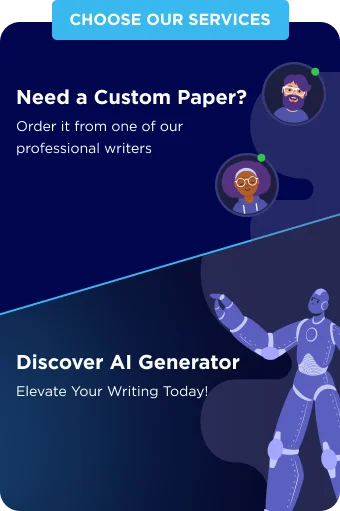
275 words = 1 page double-spaced
Looking for essays to inspire you? We have samples of all types on any topic under the sun!
Other pages.
- Garbage Argumentative Essays
- Garbage Collection Course Work
- Intellectual Course Work
- Indiscipline Course Work
- Training Program Course Work
- Injection Course Work
- Management Consulting Course Work
- Amp Course Work
- Helping Course Work
- Institute Course Work
- Food Bank Course Work
- Geography Creative Writings
- Free Essay About How To Avoid Stress
- Example Of Course Work On The Sociological Environment
- Tittle Essay
- The Rise Of Social Media In The Hospitality Industry Critical Thinking Samples
- Data Association Analysis Essays Examples
- Good Example Of Essay On Obamas Deal
- Free Case Study On The Higher Colleges Of Technology
- Example Of Essay On Why According To The Principle Of Equality Must One Show That There Are Real
- Free Essay On Digital Project Management
- Nursing Research Critique Research Paper Examples
- Sample Essay On Similarities
- The Color Of Water Ruth Essay
- Free Essay On Mechanism Of Monitoring And Evaluating Performance
- Sawer Essays
- Terracing Essays
- Grandiose Essays
- Heinz Essays
- Video Game Industry Essays
- The Delivery Essays
- Time And Money Essays
- Learning Opportunities Essays
- Hang Essays
- Physical Health Essays
- Greg Essays
- Quotation Marks Essays
- Yours Essays
- First World Essays
- Obesity Epidemic Essays
- Taco Bell Essays
- Roman History Essays
- The Road Essays
Password recovery email has been sent to [email protected]
Use your new password to log in
You are not register!
By clicking Register, you agree to our Terms of Service and that you have read our Privacy Policy .
Now you can download documents directly to your device!
Check your email! An email with your password has already been sent to you! Now you can download documents directly to your device.
or Use the QR code to Save this Paper to Your Phone
The sample is NOT original!
Short on a deadline?
Don't waste time. Get help with 11% off using code - GETWOWED
No, thanks! I'm fine with missing my deadline
Have a language expert improve your writing
Run a free plagiarism check in 10 minutes, automatically generate references for free.
- Knowledge Base
- Methodology
- Case Study | Definition, Examples & Methods
Case Study | Definition, Examples & Methods
Published on 5 May 2022 by Shona McCombes . Revised on 30 January 2023.
A case study is a detailed study of a specific subject, such as a person, group, place, event, organisation, or phenomenon. Case studies are commonly used in social, educational, clinical, and business research.
A case study research design usually involves qualitative methods , but quantitative methods are sometimes also used. Case studies are good for describing , comparing, evaluating, and understanding different aspects of a research problem .
Table of contents
When to do a case study, step 1: select a case, step 2: build a theoretical framework, step 3: collect your data, step 4: describe and analyse the case.
A case study is an appropriate research design when you want to gain concrete, contextual, in-depth knowledge about a specific real-world subject. It allows you to explore the key characteristics, meanings, and implications of the case.
Case studies are often a good choice in a thesis or dissertation . They keep your project focused and manageable when you don’t have the time or resources to do large-scale research.
You might use just one complex case study where you explore a single subject in depth, or conduct multiple case studies to compare and illuminate different aspects of your research problem.
Prevent plagiarism, run a free check.
Once you have developed your problem statement and research questions , you should be ready to choose the specific case that you want to focus on. A good case study should have the potential to:
- Provide new or unexpected insights into the subject
- Challenge or complicate existing assumptions and theories
- Propose practical courses of action to resolve a problem
- Open up new directions for future research
Unlike quantitative or experimental research, a strong case study does not require a random or representative sample. In fact, case studies often deliberately focus on unusual, neglected, or outlying cases which may shed new light on the research problem.
If you find yourself aiming to simultaneously investigate and solve an issue, consider conducting action research . As its name suggests, action research conducts research and takes action at the same time, and is highly iterative and flexible.
However, you can also choose a more common or representative case to exemplify a particular category, experience, or phenomenon.
While case studies focus more on concrete details than general theories, they should usually have some connection with theory in the field. This way the case study is not just an isolated description, but is integrated into existing knowledge about the topic. It might aim to:
- Exemplify a theory by showing how it explains the case under investigation
- Expand on a theory by uncovering new concepts and ideas that need to be incorporated
- Challenge a theory by exploring an outlier case that doesn’t fit with established assumptions
To ensure that your analysis of the case has a solid academic grounding, you should conduct a literature review of sources related to the topic and develop a theoretical framework . This means identifying key concepts and theories to guide your analysis and interpretation.
There are many different research methods you can use to collect data on your subject. Case studies tend to focus on qualitative data using methods such as interviews, observations, and analysis of primary and secondary sources (e.g., newspaper articles, photographs, official records). Sometimes a case study will also collect quantitative data .
The aim is to gain as thorough an understanding as possible of the case and its context.
In writing up the case study, you need to bring together all the relevant aspects to give as complete a picture as possible of the subject.
How you report your findings depends on the type of research you are doing. Some case studies are structured like a standard scientific paper or thesis, with separate sections or chapters for the methods , results , and discussion .
Others are written in a more narrative style, aiming to explore the case from various angles and analyse its meanings and implications (for example, by using textual analysis or discourse analysis ).
In all cases, though, make sure to give contextual details about the case, connect it back to the literature and theory, and discuss how it fits into wider patterns or debates.
Cite this Scribbr article
If you want to cite this source, you can copy and paste the citation or click the ‘Cite this Scribbr article’ button to automatically add the citation to our free Reference Generator.
McCombes, S. (2023, January 30). Case Study | Definition, Examples & Methods. Scribbr. Retrieved 14 May 2024, from https://www.scribbr.co.uk/research-methods/case-studies/
Is this article helpful?
Shona McCombes
Other students also liked, correlational research | guide, design & examples, a quick guide to experimental design | 5 steps & examples, descriptive research design | definition, methods & examples.
All You Wanted to Know About How to Write a Case Study

What do you study in your college? If you are a psychology, sociology, or anthropology student, we bet you might be familiar with what a case study is. This research method is used to study a certain person, group, or situation. In this guide from our dissertation writing service , you will learn how to write a case study professionally, from researching to citing sources properly. Also, we will explore different types of case studies and show you examples — so that you won’t have any other questions left.
What Is a Case Study?
A case study is a subcategory of research design which investigates problems and offers solutions. Case studies can range from academic research studies to corporate promotional tools trying to sell an idea—their scope is quite vast.
What Is the Difference Between a Research Paper and a Case Study?
While research papers turn the reader’s attention to a certain problem, case studies go even further. Case study guidelines require students to pay attention to details, examining issues closely and in-depth using different research methods. For example, case studies may be used to examine court cases if you study Law, or a patient's health history if you study Medicine. Case studies are also used in Marketing, which are thorough, empirically supported analysis of a good or service's performance. Well-designed case studies can be valuable for prospective customers as they can identify and solve the potential customers pain point.
Case studies involve a lot of storytelling – they usually examine particular cases for a person or a group of people. This method of research is very helpful, as it is very practical and can give a lot of hands-on information. Most commonly, the length of the case study is about 500-900 words, which is much less than the length of an average research paper.
The structure of a case study is very similar to storytelling. It has a protagonist or main character, which in your case is actually a problem you are trying to solve. You can use the system of 3 Acts to make it a compelling story. It should have an introduction, rising action, a climax where transformation occurs, falling action, and a solution.
Here is a rough formula for you to use in your case study:
Problem (Act I): > Solution (Act II) > Result (Act III) > Conclusion.
Types of Case Studies
The purpose of a case study is to provide detailed reports on an event, an institution, a place, future customers, or pretty much anything. There are a few common types of case study, but the type depends on the topic. The following are the most common domains where case studies are needed:

- Historical case studies are great to learn from. Historical events have a multitude of source info offering different perspectives. There are always modern parallels where these perspectives can be applied, compared, and thoroughly analyzed.
- Problem-oriented case studies are usually used for solving problems. These are often assigned as theoretical situations where you need to immerse yourself in the situation to examine it. Imagine you’re working for a startup and you’ve just noticed a significant flaw in your product’s design. Before taking it to the senior manager, you want to do a comprehensive study on the issue and provide solutions. On a greater scale, problem-oriented case studies are a vital part of relevant socio-economic discussions.
- Cumulative case studies collect information and offer comparisons. In business, case studies are often used to tell people about the value of a product.
- Critical case studies explore the causes and effects of a certain case.
- Illustrative case studies describe certain events, investigating outcomes and lessons learned.
Need a compelling case study? EssayPro has got you covered. Our experts are ready to provide you with detailed, insightful case studies that capture the essence of real-world scenarios. Elevate your academic work with our professional assistance.

Case Study Format
The case study format is typically made up of eight parts:
- Executive Summary. Explain what you will examine in the case study. Write an overview of the field you’re researching. Make a thesis statement and sum up the results of your observation in a maximum of 2 sentences.
- Background. Provide background information and the most relevant facts. Isolate the issues.
- Case Evaluation. Isolate the sections of the study you want to focus on. In it, explain why something is working or is not working.
- Proposed Solutions. Offer realistic ways to solve what isn’t working or how to improve its current condition. Explain why these solutions work by offering testable evidence.
- Conclusion. Summarize the main points from the case evaluations and proposed solutions. 6. Recommendations. Talk about the strategy that you should choose. Explain why this choice is the most appropriate.
- Implementation. Explain how to put the specific strategies into action.
- References. Provide all the citations.
How to Write a Case Study
Let's discover how to write a case study.

Setting Up the Research
When writing a case study, remember that research should always come first. Reading many different sources and analyzing other points of view will help you come up with more creative solutions. You can also conduct an actual interview to thoroughly investigate the customer story that you'll need for your case study. Including all of the necessary research, writing a case study may take some time. The research process involves doing the following:
- Define your objective. Explain the reason why you’re presenting your subject. Figure out where you will feature your case study; whether it is written, on video, shown as an infographic, streamed as a podcast, etc.
- Determine who will be the right candidate for your case study. Get permission, quotes, and other features that will make your case study effective. Get in touch with your candidate to see if they approve of being part of your work. Study that candidate’s situation and note down what caused it.
- Identify which various consequences could result from the situation. Follow these guidelines on how to start a case study: surf the net to find some general information you might find useful.
- Make a list of credible sources and examine them. Seek out important facts and highlight problems. Always write down your ideas and make sure to brainstorm.
- Focus on several key issues – why they exist, and how they impact your research subject. Think of several unique solutions. Draw from class discussions, readings, and personal experience. When writing a case study, focus on the best solution and explore it in depth. After having all your research in place, writing a case study will be easy. You may first want to check the rubric and criteria of your assignment for the correct case study structure.
Read Also: ' WHAT IS A CREDIBLE SOURCES ?'
Although your instructor might be looking at slightly different criteria, every case study rubric essentially has the same standards. Your professor will want you to exhibit 8 different outcomes:
- Correctly identify the concepts, theories, and practices in the discipline.
- Identify the relevant theories and principles associated with the particular study.
- Evaluate legal and ethical principles and apply them to your decision-making.
- Recognize the global importance and contribution of your case.
- Construct a coherent summary and explanation of the study.
- Demonstrate analytical and critical-thinking skills.
- Explain the interrelationships between the environment and nature.
- Integrate theory and practice of the discipline within the analysis.
Need Case Study DONE FAST?
Pick a topic, tell us your requirements and get your paper on time.
Case Study Outline
Let's look at the structure of an outline based on the issue of the alcoholic addiction of 30 people.
Introduction
- Statement of the issue: Alcoholism is a disease rather than a weakness of character.
- Presentation of the problem: Alcoholism is affecting more than 14 million people in the USA, which makes it the third most common mental illness there.
- Explanation of the terms: In the past, alcoholism was commonly referred to as alcohol dependence or alcohol addiction. Alcoholism is now the more severe stage of this addiction in the disorder spectrum.
- Hypotheses: Drinking in excess can lead to the use of other drugs.
- Importance of your story: How the information you present can help people with their addictions.
- Background of the story: Include an explanation of why you chose this topic.
- Presentation of analysis and data: Describe the criteria for choosing 30 candidates, the structure of the interview, and the outcomes.
- Strong argument 1: ex. X% of candidates dealing with anxiety and depression...
- Strong argument 2: ex. X amount of people started drinking by their mid-teens.
- Strong argument 3: ex. X% of respondents’ parents had issues with alcohol.
- Concluding statement: I have researched if alcoholism is a disease and found out that…
- Recommendations: Ways and actions for preventing alcohol use.
Writing a Case Study Draft
After you’ve done your case study research and written the outline, it’s time to focus on the draft. In a draft, you have to develop and write your case study by using: the data which you collected throughout the research, interviews, and the analysis processes that were undertaken. Follow these rules for the draft:

- Your draft should contain at least 4 sections: an introduction; a body where you should include background information, an explanation of why you decided to do this case study, and a presentation of your main findings; a conclusion where you present data; and references.
- In the introduction, you should set the pace very clearly. You can even raise a question or quote someone you interviewed in the research phase. It must provide adequate background information on the topic. The background may include analyses of previous studies on your topic. Include the aim of your case here as well. Think of it as a thesis statement. The aim must describe the purpose of your work—presenting the issues that you want to tackle. Include background information, such as photos or videos you used when doing the research.
- Describe your unique research process, whether it was through interviews, observations, academic journals, etc. The next point includes providing the results of your research. Tell the audience what you found out. Why is this important, and what could be learned from it? Discuss the real implications of the problem and its significance in the world.
- Include quotes and data (such as findings, percentages, and awards). This will add a personal touch and better credibility to the case you present. Explain what results you find during your interviews in regards to the problem and how it developed. Also, write about solutions which have already been proposed by other people who have already written about this case.
- At the end of your case study, you should offer possible solutions, but don’t worry about solving them yourself.
Use Data to Illustrate Key Points in Your Case Study
Even though your case study is a story, it should be based on evidence. Use as much data as possible to illustrate your point. Without the right data, your case study may appear weak and the readers may not be able to relate to your issue as much as they should. Let's see the examples from essay writing service :
With data: Alcoholism is affecting more than 14 million people in the USA, which makes it the third most common mental illness there. Without data: A lot of people suffer from alcoholism in the United States.
Try to include as many credible sources as possible. You may have terms or sources that could be hard for other cultures to understand. If this is the case, you should include them in the appendix or Notes for the Instructor or Professor.
Finalizing the Draft: Checklist
After you finish drafting your case study, polish it up by answering these ‘ask yourself’ questions and think about how to end your case study:
- Check that you follow the correct case study format, also in regards to text formatting.
- Check that your work is consistent with its referencing and citation style.
- Micro-editing — check for grammar and spelling issues.
- Macro-editing — does ‘the big picture’ come across to the reader? Is there enough raw data, such as real-life examples or personal experiences? Have you made your data collection process completely transparent? Does your analysis provide a clear conclusion, allowing for further research and practice?
Problems to avoid:
- Overgeneralization – Do not go into further research that deviates from the main problem.
- Failure to Document Limitations – Just as you have to clearly state the limitations of a general research study, you must describe the specific limitations inherent in the subject of analysis.
- Failure to Extrapolate All Possible Implications – Just as you don't want to over-generalize from your case study findings, you also have to be thorough in the consideration of all possible outcomes or recommendations derived from your findings.
How to Create a Title Page and Cite a Case Study
Let's see how to create an awesome title page.
Your title page depends on the prescribed citation format. The title page should include:
- A title that attracts some attention and describes your study
- The title should have the words “case study” in it
- The title should range between 5-9 words in length
- Your name and contact information
- Your finished paper should be only 500 to 1,500 words in length.With this type of assignment, write effectively and avoid fluff
Here is a template for the APA and MLA format title page:
There are some cases when you need to cite someone else's study in your own one – therefore, you need to master how to cite a case study. A case study is like a research paper when it comes to citations. You can cite it like you cite a book, depending on what style you need.
Citation Example in MLA Hill, Linda, Tarun Khanna, and Emily A. Stecker. HCL Technologies. Boston: Harvard Business Publishing, 2008. Print.
Citation Example in APA Hill, L., Khanna, T., & Stecker, E. A. (2008). HCL Technologies. Boston: Harvard Business Publishing.
Citation Example in Chicago Hill, Linda, Tarun Khanna, and Emily A. Stecker. HCL Technologies.
Case Study Examples
To give you an idea of a professional case study example, we gathered and linked some below.
Eastman Kodak Case Study
Case Study Example: Audi Trains Mexican Autoworkers in Germany
To conclude, a case study is one of the best methods of getting an overview of what happened to a person, a group, or a situation in practice. It allows you to have an in-depth glance at the real-life problems that businesses, healthcare industry, criminal justice, etc. may face. This insight helps us look at such situations in a different light. This is because we see scenarios that we otherwise would not, without necessarily being there. If you need custom essays , try our research paper writing services .
Get Help Form Qualified Writers
Crafting a case study is not easy. You might want to write one of high quality, but you don’t have the time or expertise. If you’re having trouble with your case study, help with essay request - we'll help. EssayPro writers have read and written countless case studies and are experts in endless disciplines. Request essay writing, editing, or proofreading assistance from our custom case study writing service , and all of your worries will be gone.
Don't Know Where to Start?
Crafting a case study is not easy. You might want to write one of high quality, but you don’t have the time or expertise. Request ' write my case study ' assistance from our service.
What Is A Case Study?
How to cite a case study in apa, how to write a case study.

Daniel Parker
is a seasoned educational writer focusing on scholarship guidance, research papers, and various forms of academic essays including reflective and narrative essays. His expertise also extends to detailed case studies. A scholar with a background in English Literature and Education, Daniel’s work on EssayPro blog aims to support students in achieving academic excellence and securing scholarships. His hobbies include reading classic literature and participating in academic forums.

is an expert in nursing and healthcare, with a strong background in history, law, and literature. Holding advanced degrees in nursing and public health, his analytical approach and comprehensive knowledge help students navigate complex topics. On EssayPro blog, Adam provides insightful articles on everything from historical analysis to the intricacies of healthcare policies. In his downtime, he enjoys historical documentaries and volunteering at local clinics.
Related Articles
%20(3).webp)
- All Headlines

Top 40 Most Popular Case Studies of 2021
Two cases about Hertz claimed top spots in 2021's Top 40 Most Popular Case Studies
Two cases on the uses of debt and equity at Hertz claimed top spots in the CRDT’s (Case Research and Development Team) 2021 top 40 review of cases.
Hertz (A) took the top spot. The case details the financial structure of the rental car company through the end of 2019. Hertz (B), which ranked third in CRDT’s list, describes the company’s struggles during the early part of the COVID pandemic and its eventual need to enter Chapter 11 bankruptcy.
The success of the Hertz cases was unprecedented for the top 40 list. Usually, cases take a number of years to gain popularity, but the Hertz cases claimed top spots in their first year of release. Hertz (A) also became the first ‘cooked’ case to top the annual review, as all of the other winners had been web-based ‘raw’ cases.
Besides introducing students to the complicated financing required to maintain an enormous fleet of cars, the Hertz cases also expanded the diversity of case protagonists. Kathyrn Marinello was the CEO of Hertz during this period and the CFO, Jamere Jackson is black.
Sandwiched between the two Hertz cases, Coffee 2016, a perennial best seller, finished second. “Glory, Glory, Man United!” a case about an English football team’s IPO made a surprise move to number four. Cases on search fund boards, the future of malls, Norway’s Sovereign Wealth fund, Prodigy Finance, the Mayo Clinic, and Cadbury rounded out the top ten.
Other year-end data for 2021 showed:
- Online “raw” case usage remained steady as compared to 2020 with over 35K users from 170 countries and all 50 U.S. states interacting with 196 cases.
- Fifty four percent of raw case users came from outside the U.S..
- The Yale School of Management (SOM) case study directory pages received over 160K page views from 177 countries with approximately a third originating in India followed by the U.S. and the Philippines.
- Twenty-six of the cases in the list are raw cases.
- A third of the cases feature a woman protagonist.
- Orders for Yale SOM case studies increased by almost 50% compared to 2020.
- The top 40 cases were supervised by 19 different Yale SOM faculty members, several supervising multiple cases.
CRDT compiled the Top 40 list by combining data from its case store, Google Analytics, and other measures of interest and adoption.
All of this year’s Top 40 cases are available for purchase from the Yale Management Media store .
And the Top 40 cases studies of 2021 are:
1. Hertz Global Holdings (A): Uses of Debt and Equity
2. Coffee 2016
3. Hertz Global Holdings (B): Uses of Debt and Equity 2020
4. Glory, Glory Man United!
5. Search Fund Company Boards: How CEOs Can Build Boards to Help Them Thrive
6. The Future of Malls: Was Decline Inevitable?
7. Strategy for Norway's Pension Fund Global
8. Prodigy Finance
9. Design at Mayo
10. Cadbury
11. City Hospital Emergency Room
13. Volkswagen
14. Marina Bay Sands
15. Shake Shack IPO
16. Mastercard
17. Netflix
18. Ant Financial
19. AXA: Creating the New CR Metrics
20. IBM Corporate Service Corps
21. Business Leadership in South Africa's 1994 Reforms
22. Alternative Meat Industry
23. Children's Premier
24. Khalil Tawil and Umi (A)
25. Palm Oil 2016
26. Teach For All: Designing a Global Network
27. What's Next? Search Fund Entrepreneurs Reflect on Life After Exit
28. Searching for a Search Fund Structure: A Student Takes a Tour of Various Options
30. Project Sammaan
31. Commonfund ESG
32. Polaroid
33. Connecticut Green Bank 2018: After the Raid
34. FieldFresh Foods
35. The Alibaba Group
36. 360 State Street: Real Options
37. Herman Miller
38. AgBiome
39. Nathan Cummings Foundation
40. Toyota 2010
- Bipolar Disorder
- Therapy Center
- When To See a Therapist
- Types of Therapy
- Best Online Therapy
- Best Couples Therapy
- Best Family Therapy
- Managing Stress
- Sleep and Dreaming
- Understanding Emotions
- Self-Improvement
- Healthy Relationships
- Student Resources
- Personality Types
- Guided Meditations
- Verywell Mind Insights
- 2024 Verywell Mind 25
- Mental Health in the Classroom
- Editorial Process
- Meet Our Review Board
- Crisis Support
What Is a Case Study?
Weighing the pros and cons of this method of research
Kendra Cherry, MS, is a psychosocial rehabilitation specialist, psychology educator, and author of the "Everything Psychology Book."
:max_bytes(150000):strip_icc():format(webp)/IMG_9791-89504ab694d54b66bbd72cb84ffb860e.jpg)
Cara Lustik is a fact-checker and copywriter.
:max_bytes(150000):strip_icc():format(webp)/Cara-Lustik-1000-77abe13cf6c14a34a58c2a0ffb7297da.jpg)
Verywell / Colleen Tighe
- Pros and Cons
What Types of Case Studies Are Out There?
Where do you find data for a case study, how do i write a psychology case study.
A case study is an in-depth study of one person, group, or event. In a case study, nearly every aspect of the subject's life and history is analyzed to seek patterns and causes of behavior. Case studies can be used in many different fields, including psychology, medicine, education, anthropology, political science, and social work.
The point of a case study is to learn as much as possible about an individual or group so that the information can be generalized to many others. Unfortunately, case studies tend to be highly subjective, and it is sometimes difficult to generalize results to a larger population.
While case studies focus on a single individual or group, they follow a format similar to other types of psychology writing. If you are writing a case study, we got you—here are some rules of APA format to reference.
At a Glance
A case study, or an in-depth study of a person, group, or event, can be a useful research tool when used wisely. In many cases, case studies are best used in situations where it would be difficult or impossible for you to conduct an experiment. They are helpful for looking at unique situations and allow researchers to gather a lot of˜ information about a specific individual or group of people. However, it's important to be cautious of any bias we draw from them as they are highly subjective.
What Are the Benefits and Limitations of Case Studies?
A case study can have its strengths and weaknesses. Researchers must consider these pros and cons before deciding if this type of study is appropriate for their needs.
One of the greatest advantages of a case study is that it allows researchers to investigate things that are often difficult or impossible to replicate in a lab. Some other benefits of a case study:
- Allows researchers to capture information on the 'how,' 'what,' and 'why,' of something that's implemented
- Gives researchers the chance to collect information on why one strategy might be chosen over another
- Permits researchers to develop hypotheses that can be explored in experimental research
On the other hand, a case study can have some drawbacks:
- It cannot necessarily be generalized to the larger population
- Cannot demonstrate cause and effect
- It may not be scientifically rigorous
- It can lead to bias
Researchers may choose to perform a case study if they want to explore a unique or recently discovered phenomenon. Through their insights, researchers develop additional ideas and study questions that might be explored in future studies.
It's important to remember that the insights from case studies cannot be used to determine cause-and-effect relationships between variables. However, case studies may be used to develop hypotheses that can then be addressed in experimental research.
Case Study Examples
There have been a number of notable case studies in the history of psychology. Much of Freud's work and theories were developed through individual case studies. Some great examples of case studies in psychology include:
- Anna O : Anna O. was a pseudonym of a woman named Bertha Pappenheim, a patient of a physician named Josef Breuer. While she was never a patient of Freud's, Freud and Breuer discussed her case extensively. The woman was experiencing symptoms of a condition that was then known as hysteria and found that talking about her problems helped relieve her symptoms. Her case played an important part in the development of talk therapy as an approach to mental health treatment.
- Phineas Gage : Phineas Gage was a railroad employee who experienced a terrible accident in which an explosion sent a metal rod through his skull, damaging important portions of his brain. Gage recovered from his accident but was left with serious changes in both personality and behavior.
- Genie : Genie was a young girl subjected to horrific abuse and isolation. The case study of Genie allowed researchers to study whether language learning was possible, even after missing critical periods for language development. Her case also served as an example of how scientific research may interfere with treatment and lead to further abuse of vulnerable individuals.
Such cases demonstrate how case research can be used to study things that researchers could not replicate in experimental settings. In Genie's case, her horrific abuse denied her the opportunity to learn a language at critical points in her development.
This is clearly not something researchers could ethically replicate, but conducting a case study on Genie allowed researchers to study phenomena that are otherwise impossible to reproduce.
There are a few different types of case studies that psychologists and other researchers might use:
- Collective case studies : These involve studying a group of individuals. Researchers might study a group of people in a certain setting or look at an entire community. For example, psychologists might explore how access to resources in a community has affected the collective mental well-being of those who live there.
- Descriptive case studies : These involve starting with a descriptive theory. The subjects are then observed, and the information gathered is compared to the pre-existing theory.
- Explanatory case studies : These are often used to do causal investigations. In other words, researchers are interested in looking at factors that may have caused certain things to occur.
- Exploratory case studies : These are sometimes used as a prelude to further, more in-depth research. This allows researchers to gather more information before developing their research questions and hypotheses .
- Instrumental case studies : These occur when the individual or group allows researchers to understand more than what is initially obvious to observers.
- Intrinsic case studies : This type of case study is when the researcher has a personal interest in the case. Jean Piaget's observations of his own children are good examples of how an intrinsic case study can contribute to the development of a psychological theory.
The three main case study types often used are intrinsic, instrumental, and collective. Intrinsic case studies are useful for learning about unique cases. Instrumental case studies help look at an individual to learn more about a broader issue. A collective case study can be useful for looking at several cases simultaneously.
The type of case study that psychology researchers use depends on the unique characteristics of the situation and the case itself.
There are a number of different sources and methods that researchers can use to gather information about an individual or group. Six major sources that have been identified by researchers are:
- Archival records : Census records, survey records, and name lists are examples of archival records.
- Direct observation : This strategy involves observing the subject, often in a natural setting . While an individual observer is sometimes used, it is more common to utilize a group of observers.
- Documents : Letters, newspaper articles, administrative records, etc., are the types of documents often used as sources.
- Interviews : Interviews are one of the most important methods for gathering information in case studies. An interview can involve structured survey questions or more open-ended questions.
- Participant observation : When the researcher serves as a participant in events and observes the actions and outcomes, it is called participant observation.
- Physical artifacts : Tools, objects, instruments, and other artifacts are often observed during a direct observation of the subject.
If you have been directed to write a case study for a psychology course, be sure to check with your instructor for any specific guidelines you need to follow. If you are writing your case study for a professional publication, check with the publisher for their specific guidelines for submitting a case study.
Here is a general outline of what should be included in a case study.
Section 1: A Case History
This section will have the following structure and content:
Background information : The first section of your paper will present your client's background. Include factors such as age, gender, work, health status, family mental health history, family and social relationships, drug and alcohol history, life difficulties, goals, and coping skills and weaknesses.
Description of the presenting problem : In the next section of your case study, you will describe the problem or symptoms that the client presented with.
Describe any physical, emotional, or sensory symptoms reported by the client. Thoughts, feelings, and perceptions related to the symptoms should also be noted. Any screening or diagnostic assessments that are used should also be described in detail and all scores reported.
Your diagnosis : Provide your diagnosis and give the appropriate Diagnostic and Statistical Manual code. Explain how you reached your diagnosis, how the client's symptoms fit the diagnostic criteria for the disorder(s), or any possible difficulties in reaching a diagnosis.
Section 2: Treatment Plan
This portion of the paper will address the chosen treatment for the condition. This might also include the theoretical basis for the chosen treatment or any other evidence that might exist to support why this approach was chosen.
- Cognitive behavioral approach : Explain how a cognitive behavioral therapist would approach treatment. Offer background information on cognitive behavioral therapy and describe the treatment sessions, client response, and outcome of this type of treatment. Make note of any difficulties or successes encountered by your client during treatment.
- Humanistic approach : Describe a humanistic approach that could be used to treat your client, such as client-centered therapy . Provide information on the type of treatment you chose, the client's reaction to the treatment, and the end result of this approach. Explain why the treatment was successful or unsuccessful.
- Psychoanalytic approach : Describe how a psychoanalytic therapist would view the client's problem. Provide some background on the psychoanalytic approach and cite relevant references. Explain how psychoanalytic therapy would be used to treat the client, how the client would respond to therapy, and the effectiveness of this treatment approach.
- Pharmacological approach : If treatment primarily involves the use of medications, explain which medications were used and why. Provide background on the effectiveness of these medications and how monotherapy may compare with an approach that combines medications with therapy or other treatments.
This section of a case study should also include information about the treatment goals, process, and outcomes.
When you are writing a case study, you should also include a section where you discuss the case study itself, including the strengths and limitiations of the study. You should note how the findings of your case study might support previous research.
In your discussion section, you should also describe some of the implications of your case study. What ideas or findings might require further exploration? How might researchers go about exploring some of these questions in additional studies?
Need More Tips?
Here are a few additional pointers to keep in mind when formatting your case study:
- Never refer to the subject of your case study as "the client." Instead, use their name or a pseudonym.
- Read examples of case studies to gain an idea about the style and format.
- Remember to use APA format when citing references .
Crowe S, Cresswell K, Robertson A, Huby G, Avery A, Sheikh A. The case study approach . BMC Med Res Methodol . 2011;11:100.
Crowe S, Cresswell K, Robertson A, Huby G, Avery A, Sheikh A. The case study approach . BMC Med Res Methodol . 2011 Jun 27;11:100. doi:10.1186/1471-2288-11-100
Gagnon, Yves-Chantal. The Case Study as Research Method: A Practical Handbook . Canada, Chicago Review Press Incorporated DBA Independent Pub Group, 2010.
Yin, Robert K. Case Study Research and Applications: Design and Methods . United States, SAGE Publications, 2017.
By Kendra Cherry, MSEd Kendra Cherry, MS, is a psychosocial rehabilitation specialist, psychology educator, and author of the "Everything Psychology Book."
We use essential cookies to make Venngage work. By clicking “Accept All Cookies”, you agree to the storing of cookies on your device to enhance site navigation, analyze site usage, and assist in our marketing efforts.
Manage Cookies
Cookies and similar technologies collect certain information about how you’re using our website. Some of them are essential, and without them you wouldn’t be able to use Venngage. But others are optional, and you get to choose whether we use them or not.
Strictly Necessary Cookies
These cookies are always on, as they’re essential for making Venngage work, and making it safe. Without these cookies, services you’ve asked for can’t be provided.
Show cookie providers
- Google Login
Functionality Cookies
These cookies help us provide enhanced functionality and personalisation, and remember your settings. They may be set by us or by third party providers.
Performance Cookies
These cookies help us analyze how many people are using Venngage, where they come from and how they're using it. If you opt out of these cookies, we can’t get feedback to make Venngage better for you and all our users.
- Google Analytics
Targeting Cookies
These cookies are set by our advertising partners to track your activity and show you relevant Venngage ads on other sites as you browse the internet.
- Google Tag Manager
- Infographics
- Daily Infographics
- Popular Templates
- Accessibility
- Graphic Design
- Graphs and Charts
- Data Visualization
- Human Resources
- Beginner Guides
Blog Business How to Present a Case Study like a Pro (With Examples)
How to Present a Case Study like a Pro (With Examples)
Written by: Danesh Ramuthi Sep 07, 2023

Okay, let’s get real: case studies can be kinda snooze-worthy. But guess what? They don’t have to be!
In this article, I will cover every element that transforms a mere report into a compelling case study, from selecting the right metrics to using persuasive narrative techniques.
And if you’re feeling a little lost, don’t worry! There are cool tools like Venngage’s Case Study Creator to help you whip up something awesome, even if you’re short on time. Plus, the pre-designed case study templates are like instant polish because let’s be honest, everyone loves a shortcut.
Click to jump ahead:
What is a case study presentation?
What is the purpose of presenting a case study, how to structure a case study presentation, how long should a case study presentation be, 5 case study presentation examples with templates, 6 tips for delivering an effective case study presentation, 5 common mistakes to avoid in a case study presentation, how to present a case study faqs.
A case study presentation involves a comprehensive examination of a specific subject, which could range from an individual, group, location, event, organization or phenomenon.
They’re like puzzles you get to solve with the audience, all while making you think outside the box.
Unlike a basic report or whitepaper, the purpose of a case study presentation is to stimulate critical thinking among the viewers.
The primary objective of a case study is to provide an extensive and profound comprehension of the chosen topic. You don’t just throw numbers at your audience. You use examples and real-life cases to make you think and see things from different angles.

The primary purpose of presenting a case study is to offer a comprehensive, evidence-based argument that informs, persuades and engages your audience.
Here’s the juicy part: presenting that case study can be your secret weapon. Whether you’re pitching a groundbreaking idea to a room full of suits or trying to impress your professor with your A-game, a well-crafted case study can be the magic dust that sprinkles brilliance over your words.
Think of it like digging into a puzzle you can’t quite crack . A case study lets you explore every piece, turn it over and see how it fits together. This close-up look helps you understand the whole picture, not just a blurry snapshot.
It’s also your chance to showcase how you analyze things, step by step, until you reach a conclusion. It’s all about being open and honest about how you got there.
Besides, presenting a case study gives you an opportunity to connect data and real-world scenarios in a compelling narrative. It helps to make your argument more relatable and accessible, increasing its impact on your audience.
One of the contexts where case studies can be very helpful is during the job interview. In some job interviews, you as candidates may be asked to present a case study as part of the selection process.
Having a case study presentation prepared allows the candidate to demonstrate their ability to understand complex issues, formulate strategies and communicate their ideas effectively.

The way you present a case study can make all the difference in how it’s received. A well-structured presentation not only holds the attention of your audience but also ensures that your key points are communicated clearly and effectively.
In this section, let’s go through the key steps that’ll help you structure your case study presentation for maximum impact.
Let’s get into it.
Open with an introductory overview
Start by introducing the subject of your case study and its relevance. Explain why this case study is important and who would benefit from the insights gained. This is your opportunity to grab your audience’s attention.

Explain the problem in question
Dive into the problem or challenge that the case study focuses on. Provide enough background information for the audience to understand the issue. If possible, quantify the problem using data or metrics to show the magnitude or severity.

Detail the solutions to solve the problem
After outlining the problem, describe the steps taken to find a solution. This could include the methodology, any experiments or tests performed and the options that were considered. Make sure to elaborate on why the final solution was chosen over the others.

Key stakeholders Involved
Talk about the individuals, groups or organizations that were directly impacted by or involved in the problem and its solution.
Stakeholders may experience a range of outcomes—some may benefit, while others could face setbacks.
For example, in a business transformation case study, employees could face job relocations or changes in work culture, while shareholders might be looking at potential gains or losses.
Discuss the key results & outcomes
Discuss the results of implementing the solution. Use data and metrics to back up your statements. Did the solution meet its objectives? What impact did it have on the stakeholders? Be honest about any setbacks or areas for improvement as well.

Include visuals to support your analysis
Visual aids can be incredibly effective in helping your audience grasp complex issues. Utilize charts, graphs, images or video clips to supplement your points. Make sure to explain each visual and how it contributes to your overall argument.
Pie charts illustrate the proportion of different components within a whole, useful for visualizing market share, budget allocation or user demographics.
This is particularly useful especially if you’re displaying survey results in your case study presentation.

Stacked charts on the other hand are perfect for visualizing composition and trends. This is great for analyzing things like customer demographics, product breakdowns or budget allocation in your case study.
Consider this example of a stacked bar chart template. It provides a straightforward summary of the top-selling cake flavors across various locations, offering a quick and comprehensive view of the data.

Not the chart you’re looking for? Browse Venngage’s gallery of chart templates to find the perfect one that’ll captivate your audience and level up your data storytelling.

Recommendations and next steps
Wrap up by providing recommendations based on the case study findings. Outline the next steps that stakeholders should take to either expand on the success of the project or address any remaining challenges.
Acknowledgments and references
Thank the people who contributed to the case study and helped in the problem-solving process. Cite any external resources, reports or data sets that contributed to your analysis.
Feedback & Q&A session
Open the floor for questions and feedback from your audience. This allows for further discussion and can provide additional insights that may not have been considered previously.
Closing remarks
Conclude the presentation by summarizing the key points and emphasizing the takeaways. Thank your audience for their time and participation and express your willingness to engage in further discussions or collaborations on the subject.

Well, the length of a case study presentation can vary depending on the complexity of the topic and the needs of your audience. However, a typical business or academic presentation often lasts between 15 to 30 minutes.
This time frame usually allows for a thorough explanation of the case while maintaining audience engagement. However, always consider leaving a few minutes at the end for a Q&A session to address any questions or clarify points made during the presentation.
When it comes to presenting a compelling case study, having a well-structured template can be a game-changer.
It helps you organize your thoughts, data and findings in a coherent and visually pleasing manner.
Not all case studies are created equal and different scenarios require distinct approaches for maximum impact.
To save you time and effort, I have curated a list of 5 versatile case study presentation templates, each designed for specific needs and audiences.
Here are some best case study presentation examples that showcase effective strategies for engaging your audience and conveying complex information clearly.
1 . Lab report case study template
Ever feel like your research gets lost in a world of endless numbers and jargon? Lab case studies are your way out!
Think of it as building a bridge between your cool experiment and everyone else. It’s more than just reporting results – it’s explaining the “why” and “how” in a way that grabs attention and makes sense.
This lap report template acts as a blueprint for your report, guiding you through each essential section (introduction, methods, results, etc.) in a logical order.

Want to present your research like a pro? Browse our research presentation template gallery for creative inspiration!
2. Product case study template
It’s time you ditch those boring slideshows and bullet points because I’ve got a better way to win over clients: product case study templates.
Instead of just listing features and benefits, you get to create a clear and concise story that shows potential clients exactly what your product can do for them. It’s like painting a picture they can easily visualize, helping them understand the value your product brings to the table.
Grab the template below, fill in the details, and watch as your product’s impact comes to life!

3. Content marketing case study template
In digital marketing, showcasing your accomplishments is as vital as achieving them.
A well-crafted case study not only acts as a testament to your successes but can also serve as an instructional tool for others.
With this coral content marketing case study template—a perfect blend of vibrant design and structured documentation, you can narrate your marketing triumphs effectively.

4. Case study psychology template
Understanding how people tick is one of psychology’s biggest quests and case studies are like magnifying glasses for the mind. They offer in-depth looks at real-life behaviors, emotions and thought processes, revealing fascinating insights into what makes us human.
Writing a top-notch case study, though, can be a challenge. It requires careful organization, clear presentation and meticulous attention to detail. That’s where a good case study psychology template comes in handy.
Think of it as a helpful guide, taking care of formatting and structure while you focus on the juicy content. No more wrestling with layouts or margins – just pour your research magic into crafting a compelling narrative.

5. Lead generation case study template
Lead generation can be a real head-scratcher. But here’s a little help: a lead generation case study.
Think of it like a friendly handshake and a confident resume all rolled into one. It’s your chance to showcase your expertise, share real-world successes and offer valuable insights. Potential clients get to see your track record, understand your approach and decide if you’re the right fit.
No need to start from scratch, though. This lead generation case study template guides you step-by-step through crafting a clear, compelling narrative that highlights your wins and offers actionable tips for others. Fill in the gaps with your specific data and strategies, and voilà! You’ve got a powerful tool to attract new customers.

Related: 15+ Professional Case Study Examples [Design Tips + Templates]
So, you’ve spent hours crafting the perfect case study and are now tasked with presenting it. Crafting the case study is only half the battle; delivering it effectively is equally important.
Whether you’re facing a room of executives, academics or potential clients, how you present your findings can make a significant difference in how your work is received.
Forget boring reports and snooze-inducing presentations! Let’s make your case study sing. Here are some key pointers to turn information into an engaging and persuasive performance:
- Know your audience : Tailor your presentation to the knowledge level and interests of your audience. Remember to use language and examples that resonate with them.
- Rehearse : Rehearsing your case study presentation is the key to a smooth delivery and for ensuring that you stay within the allotted time. Practice helps you fine-tune your pacing, hone your speaking skills with good word pronunciations and become comfortable with the material, leading to a more confident, conversational and effective presentation.
- Start strong : Open with a compelling introduction that grabs your audience’s attention. You might want to use an interesting statistic, a provocative question or a brief story that sets the stage for your case study.
- Be clear and concise : Avoid jargon and overly complex sentences. Get to the point quickly and stay focused on your objectives.
- Use visual aids : Incorporate slides with graphics, charts or videos to supplement your verbal presentation. Make sure they are easy to read and understand.
- Tell a story : Use storytelling techniques to make the case study more engaging. A well-told narrative can help you make complex data more relatable and easier to digest.

Ditching the dry reports and slide decks? Venngage’s case study templates let you wow customers with your solutions and gain insights to improve your business plan. Pre-built templates, visual magic and customer captivation – all just a click away. Go tell your story and watch them say “wow!”
Nailed your case study, but want to make your presentation even stronger? Avoid these common mistakes to ensure your audience gets the most out of it:
Overloading with information
A case study is not an encyclopedia. Overloading your presentation with excessive data, text or jargon can make it cumbersome and difficult for the audience to digest the key points. Stick to what’s essential and impactful. Need help making your data clear and impactful? Our data presentation templates can help! Find clear and engaging visuals to showcase your findings.
Lack of structure
Jumping haphazardly between points or topics can confuse your audience. A well-structured presentation, with a logical flow from introduction to conclusion, is crucial for effective communication.
Ignoring the audience
Different audiences have different needs and levels of understanding. Failing to adapt your presentation to your audience can result in a disconnect and a less impactful presentation.
Poor visual elements
While content is king, poor design or lack of visual elements can make your case study dull or hard to follow. Make sure you use high-quality images, graphs and other visual aids to support your narrative.
Not focusing on results
A case study aims to showcase a problem and its solution, but what most people care about are the results. Failing to highlight or adequately explain the outcomes can make your presentation fall flat.
How to start a case study presentation?
Starting a case study presentation effectively involves a few key steps:
- Grab attention : Open with a hook—an intriguing statistic, a provocative question or a compelling visual—to engage your audience from the get-go.
- Set the stage : Briefly introduce the subject, context and relevance of the case study to give your audience an idea of what to expect.
- Outline objectives : Clearly state what the case study aims to achieve. Are you solving a problem, proving a point or showcasing a success?
- Agenda : Give a quick outline of the key sections or topics you’ll cover to help the audience follow along.
- Set expectations : Let your audience know what you want them to take away from the presentation, whether it’s knowledge, inspiration or a call to action.
How to present a case study on PowerPoint and on Google Slides?
Presenting a case study on PowerPoint and Google Slides involves a structured approach for clarity and impact using presentation slides :
- Title slide : Start with a title slide that includes the name of the case study, your name and any relevant institutional affiliations.
- Introduction : Follow with a slide that outlines the problem or situation your case study addresses. Include a hook to engage the audience.
- Objectives : Clearly state the goals of the case study in a dedicated slide.
- Findings : Use charts, graphs and bullet points to present your findings succinctly.
- Analysis : Discuss what the findings mean, drawing on supporting data or secondary research as necessary.
- Conclusion : Summarize key takeaways and results.
- Q&A : End with a slide inviting questions from the audience.
What’s the role of analysis in a case study presentation?
The role of analysis in a case study presentation is to interpret the data and findings, providing context and meaning to them.
It helps your audience understand the implications of the case study, connects the dots between the problem and the solution and may offer recommendations for future action.
Is it important to include real data and results in the presentation?
Yes, including real data and results in a case study presentation is crucial to show experience, credibility and impact. Authentic data lends weight to your findings and conclusions, enabling the audience to trust your analysis and take your recommendations more seriously
How do I conclude a case study presentation effectively?
To conclude a case study presentation effectively, summarize the key findings, insights and recommendations in a clear and concise manner.
End with a strong call-to-action or a thought-provoking question to leave a lasting impression on your audience.
What’s the best way to showcase data in a case study presentation ?
The best way to showcase data in a case study presentation is through visual aids like charts, graphs and infographics which make complex information easily digestible, engaging and creative.
Don’t just report results, visualize them! This template for example lets you transform your social media case study into a captivating infographic that sparks conversation.

Choose the type of visual that best represents the data you’re showing; for example, use bar charts for comparisons or pie charts for parts of a whole.
Ensure that the visuals are high-quality and clearly labeled, so the audience can quickly grasp the key points.
Keep the design consistent and simple, avoiding clutter or overly complex visuals that could distract from the message.
Choose a template that perfectly suits your case study where you can utilize different visual aids for maximum impact.
Need more inspiration on how to turn numbers into impact with the help of infographics? Our ready-to-use infographic templates take the guesswork out of creating visual impact for your case studies with just a few clicks.
Related: 10+ Case Study Infographic Templates That Convert
Congrats on mastering the art of compelling case study presentations! This guide has equipped you with all the essentials, from structure and nuances to avoiding common pitfalls. You’re ready to impress any audience, whether in the boardroom, the classroom or beyond.
And remember, you’re not alone in this journey. Venngage’s Case Study Creator is your trusty companion, ready to elevate your presentations from ordinary to extraordinary. So, let your confidence shine, leverage your newly acquired skills and prepare to deliver presentations that truly resonate.
Go forth and make a lasting impact!
Discover popular designs

Infographic maker

Brochure maker

White paper online

Newsletter creator

Flyer maker

Timeline maker

Letterhead maker

Mind map maker

Ebook maker
Writing A Case Study
Case Study Examples
Brilliant Case Study Examples and Templates For Your Help
15 min read

People also read
A Complete Case Study Writing Guide With Examples
Simple Case Study Format for Students to Follow
Understand the Types of Case Study Here
It’s no surprise that writing a case study is one of the most challenging academic tasks for students. You’re definitely not alone here!
Most people don't realize that there are specific guidelines to follow when writing a case study. If you don't know where to start, it's easy to get overwhelmed and give up before you even begin.
Don't worry! Let us help you out!
We've collected over 25 free case study examples with solutions just for you. These samples with solutions will help you win over your panel and score high marks on your case studies.
So, what are you waiting for? Let's dive in and learn the secrets to writing a successful case study.
- 1. An Overview of Case Studies
- 2. Case Study Examples for Students
- 3. Business Case Study Examples
- 4. Medical Case Study Examples
- 5. Psychology Case Study Examples
- 6. Sales Case Study Examples
- 7. Interview Case Study Examples
- 8. Marketing Case Study Examples
- 9. Tips to Write a Good Case Study
An Overview of Case Studies
A case study is a research method used to study a particular individual, group, or situation in depth. It involves analyzing and interpreting data from a variety of sources to gain insight into the subject being studied.
Case studies are often used in psychology, business, and education to explore complicated problems and find solutions. They usually have detailed descriptions of the subject, background info, and an analysis of the main issues.
The goal of a case study is to provide a comprehensive understanding of the subject. Typically, case studies can be divided into three parts, challenges, solutions, and results.
Here is a case study sample PDF so you can have a clearer understanding of what a case study actually is:
Case Study Sample PDF
How to Write a Case Study Examples
Learn how to write a case study with the help of our comprehensive case study guide.
Case Study Examples for Students
Quite often, students are asked to present case studies in their academic journeys. The reason instructors assign case studies is for students to sharpen their critical analysis skills, understand how companies make profits, etc.
Below are some case study examples in research, suitable for students:
Case Study Example in Software Engineering
Qualitative Research Case Study Sample
Software Quality Assurance Case Study
Social Work Case Study Example
Ethical Case Study
Case Study Example PDF
These examples can guide you on how to structure and format your own case studies.
Struggling with formatting your case study? Check this case study format guide and perfect your document’s structure today.
Business Case Study Examples
A business case study examines a business’s specific challenge or goal and how it should be solved. Business case studies usually focus on several details related to the initial challenge and proposed solution.
To help you out, here are some samples so you can create case studies that are related to businesses:
Here are some more business case study examples:
Business Case Studies PDF
Business Case Studies Example
Typically, a business case study discovers one of your customer's stories and how you solved a problem for them. It allows your prospects to see how your solutions address their needs.
Medical Case Study Examples
Medical case studies are an essential part of medical education. They help students to understand how to diagnose and treat patients.
Here are some medical case study examples to help you.
Medical Case Study Example
Nursing Case Study Example
Want to understand the various types of case studies? Check out our types of case study blog to select the perfect type.
Psychology Case Study Examples
Case studies are a great way of investigating individuals with psychological abnormalities. This is why it is a very common assignment in psychology courses.
By examining all the aspects of your subject’s life, you discover the possible causes of exhibiting such behavior.
For your help, here are some interesting psychology case study examples:
Psychology Case Study Example
Mental Health Case Study Example
Sales Case Study Examples
Case studies are important tools for sales teams’ performance improvement. By examining sales successes, teams can gain insights into effective strategies and create action plans to employ similar tactics.
By researching case studies of successful sales campaigns, sales teams can more accurately identify challenges and develop solutions.
Sales Case Study Example
Interview Case Study Examples
Interview case studies provide businesses with invaluable information. This data allows them to make informed decisions related to certain markets or subjects.
Interview Case Study Example
Marketing Case Study Examples
Marketing case studies are real-life stories that showcase how a business solves a problem. They typically discuss how a business achieves a goal using a specific marketing strategy or tactic.
They typically describe a challenge faced by a business, the solution implemented, and the results achieved.
This is a short sample marketing case study for you to get an idea of what an actual marketing case study looks like.
Here are some more popular marketing studies that show how companies use case studies as a means of marketing and promotion:
“Chevrolet Discover the Unexpected” by Carol H. Williams
This case study explores Chevrolet's “ DTU Journalism Fellows ” program. The case study uses the initials “DTU” to generate interest and encourage readers to learn more.
Multiple types of media, such as images and videos, are used to explain the challenges faced. The case study concludes with an overview of the achievements that were met.
Key points from the case study include:
- Using a well-known brand name in the title can create interest.
- Combining different media types, such as headings, images, and videos, can help engage readers and make the content more memorable.
- Providing a summary of the key achievements at the end of the case study can help readers better understand the project's impact.
“The Met” by Fantasy
“ The Met ” by Fantasy is a fictional redesign of the Metropolitan Museum of Art in New York City, created by the design studio Fantasy. The case study clearly and simply showcases the museum's website redesign.
The Met emphasizes the website’s features and interface by showcasing each section of the interface individually, allowing the readers to concentrate on the significant elements.
For those who prefer text, each feature includes an objective description. The case study also includes a “Contact Us” call-to-action at the bottom of the page, inviting visitors to contact the company.
Key points from this “The Met” include:
- Keeping the case study simple and clean can help readers focus on the most important aspects.
- Presenting the features and solutions with a visual showcase can be more effective than writing a lot of text.
- Including a clear call-to-action at the end of the case study can encourage visitors to contact the company for more information.
“Better Experiences for All” by Herman Miller
Herman Miller's minimalist approach to furniture design translates to their case study, “ Better Experiences for All ”, for a Dubai hospital. The page features a captivating video with closed-captioning and expandable text for accessibility.
The case study presents a wealth of information in a concise format, enabling users to grasp the complexities of the strategy with ease. It concludes with a client testimonial and a list of furniture items purchased from the brand.
Key points from the “Better Experiences” include:
- Make sure your case study is user-friendly by including accessibility features like closed captioning and expandable text.
- Include a list of products that were used in the project to guide potential customers.
“NetApp” by Evisort
Evisort's case study on “ NetApp ” stands out for its informative and compelling approach. The study begins with a client-centric overview of NetApp, strategically directing attention to the client rather than the company or team involved.
The case study incorporates client quotes and explores NetApp’s challenges during COVID-19. Evisort showcases its value as a client partner by showing how its services supported NetApp through difficult times.
- Provide an overview of the company in the client’s words, and put focus on the customer.
- Highlight how your services can help clients during challenging times.
- Make your case study accessible by providing it in various formats.
“Red Sox Season Campaign,” by CTP Boston
The “ Red Sox Season Campaign ” showcases a perfect blend of different media, such as video, text, and images. Upon visiting the page, the video plays automatically, there are videos of Red Sox players, their images, and print ads that can be enlarged with a click.
The page features an intuitive design and invites viewers to appreciate CTP's well-rounded campaign for Boston's beloved baseball team. There’s also a CTA that prompts viewers to learn how CTP can create a similar campaign for their brand.
Some key points to take away from the “Red Sox Season Campaign”:
- Including a variety of media such as video, images, and text can make your case study more engaging and compelling.
- Include a call-to-action at the end of your study that encourages viewers to take the next step towards becoming a customer or prospect.
“Airbnb + Zendesk” by Zendesk
The case study by Zendesk, titled “ Airbnb + Zendesk : Building a powerful solution together,” showcases a true partnership between Airbnb and Zendesk.
The article begins with an intriguing opening statement, “Halfway around the globe is a place to stay with your name on it. At least for a weekend,” and uses stunning images of beautiful Airbnb locations to captivate readers.
Instead of solely highlighting Zendesk's product, the case study is crafted to tell a good story and highlight Airbnb's service in detail. This strategy makes the case study more authentic and relatable.
Some key points to take away from this case study are:
- Use client's offerings' images rather than just screenshots of your own product or service.
- To begin the case study, it is recommended to include a distinct CTA. For instance, Zendesk presents two alternatives, namely to initiate a trial or seek a solution.
“Influencer Marketing” by Trend and WarbyParker
The case study "Influencer Marketing" by Trend and Warby Parker highlights the potential of influencer content marketing, even when working with a limited budget.
The “Wearing Warby” campaign involved influencers wearing Warby Parker glasses during their daily activities, providing a glimpse of the brand's products in use.
This strategy enhanced the brand's relatability with influencers' followers. While not detailing specific tactics, the case study effectively illustrates the impact of third-person case studies in showcasing campaign results.
Key points to take away from this case study are:
- Influencer marketing can be effective even with a limited budget.
- Showcasing products being used in everyday life can make a brand more approachable and relatable.
- Third-person case studies can be useful in highlighting the success of a campaign.
Marketing Case Study Example
Marketing Case Study Template
Now that you have read multiple case study examples, hop on to our tips.
Tips to Write a Good Case Study
Here are some note-worthy tips to craft a winning case study
- Define the purpose of the case study This will help you to focus on the most important aspects of the case. The case study objective helps to ensure that your finished product is concise and to the point.
- Choose a real-life example. One of the best ways to write a successful case study is to choose a real-life example. This will give your readers a chance to see how the concepts apply in a real-world setting.
- Keep it brief. This means that you should only include information that is directly relevant to your topic and avoid adding unnecessary details.
- Use strong evidence. To make your case study convincing, you will need to use strong evidence. This can include statistics, data from research studies, or quotes from experts in the field.
- Edit and proofread your work. Before you submit your case study, be sure to edit and proofread your work carefully. This will help to ensure that there are no errors and that your paper is clear and concise.
There you go!
We’re sure that now you have secrets to writing a great case study at your fingertips! This blog teaches the key guidelines of various case studies with samples. So grab your pen and start crafting a winning case study right away!
Having said that, we do understand that some of you might be having a hard time writing compelling case studies.
But worry not! Our expert case study writing service is here to take all your case-writing blues away!
With 100% thorough research guaranteed, our online essay service can craft an amazing case study within 24 hours!
So why delay? Let us help you shine in the eyes of your instructor!

Write Essay Within 60 Seconds!

Dr. Barbara is a highly experienced writer and author who holds a Ph.D. degree in public health from an Ivy League school. She has worked in the medical field for many years, conducting extensive research on various health topics. Her writing has been featured in several top-tier publications.

Paper Due? Why Suffer? That’s our Job!
Keep reading


- Intermediate
Case Studies
- All Conversation Types Case Studies (7) Reading (7) Vocabulary (352) Grammar (15) Phrasal Verbs (10) Idioms and Phrases (3) Pictures (12) Videos (3)
- All Topics Business (1) Children (1) Education (1) Family (1) Life (2) Music (1) Relationships (1) Work (1)
- All Levels Intermediate (6) Advanced (1)

Tanya’s Parenting Problems

Pursuing A Dream

Drinking Problems

Mugged at Knifepoint

Struggling With Her Mother-in-Law

Dealing With Micromanagement

Language Academy Charity Event
Topic: Case Study

Would you invest in a franchise?
With this lesson, students master key collocations to talk about business and investment, analyze the franchise business model, and enhance listening skills with an informative video about McDonald’s.

That’s a bit over the top!
This lesson focuses on business competition vocabulary through learning about unusual business ideas. Students learn useful phrases, watch a video, and discuss business cases.

Mergers and acquisitions
In this lesson, students learn and practise some advanced Business English vocabulary. They also watch a video and talk about mergers and acquisitions.

Competition in business
With this lesson, students talk about business, watch a video about competition and learn some useful Business English vocabulary.

What does it take to start an e-commerce business?
In this ESL lesson on e-commerce students get a chance to talk about starting a business, watch a video about people who did, discuss e-commerce and its advantages and learn some vocabulary related to the topic.

Ethics of lying
In this speaking lesson about lying, students watch a video, talk about the ethics of lying and discuss whether they would lie in some difficult situations.

Let’s talk about projects!
In this lesson about projects, students watch a video ad, talk about their experience with projects and discuss different project management problems.

Dealing with an insecure boss
In this lesson, students watch a video about dealing with insecure bosses and learn some vocabulary while talking about leadership. They also discuss two case studies.

The future of bricks-and-mortar retail shopping
In this Business English speaking class, students watch a video about the future of bricks-and-mortar retail shopping and discuss shopping trends.
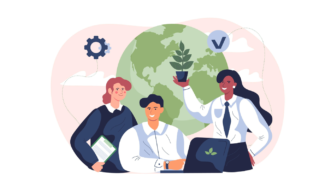
Earth is our only shareholder
In this lesson, students learn and practise using compound adjectives. They also discuss corporate misconduct and watch a video about a founder who gave his company away to fight climate change.

Elegance versus bling (case study)
In this lesson, students watch a video about a company facing problems, learn advanced phrases for giving opinions, and discuss case studies.

The circular economy
In this lesson, students discover pros and cons of the linear and circular economy and learn some new vocabulary and collocations related to the topic. They also work on a case study and come up with strategies to transform a company following a linear model into a more circular one.

Data science and the NBA
With this data science lesson plan, students will learn a lot of advanced vocabulary related to the topic and put it into practice through a series of written and oral activities.

Decision time (business case study)
Thanks to this business case study worksheet, students learn phrasal verbs to talk about companies, watch a video presenting a case study and discuss situations when companies face different problems.

There’s no business without challenges
This Business English worksheet for B1 students gives them opportunity to speak about different businesses and their challenges, and analyse case studies.

Modern workplace amenities (Business English speaking class)
This Business English lesson plan looks at the modern office spaces and the cool office amenities we have. It focuses mainly on practising speaking skills.
Subscribe to get premium content
Subscribe to get access to professional, ready-to-use lesson plans in both digital and printable formats . Discover a variety of lesson types: Standard Lessons, Speaking Classes, Critical Reading Club worksheets and Flipped Classroom lesson plans.
Username or Email Address
Remember Me
Circular economy introduction

What is a circular economy?
Other available languages
- Circular economy explained
The circular economy is a system where materials never become waste and nature is regenerated. In a circular economy, products and materials are kept in circulation through processes like maintenance, reuse, refurbishment, remanufacture, recycling, and composting. The circular economy tackles climate change and other global challenges, like biodiversity loss, waste, and pollution, by decoupling economic activity from the consumption of finite resources.
The circular economy is based on three principles, driven by design:
Eliminate waste and pollution.
Circulate products and materials (at their highest value)
Regenerate nature
In our current economy, we take materials from the Earth, make products from them, and eventually throw them away as waste – the process is linear. In a circular economy, by contrast, we stop waste being produced in the first place.
We must transform every element of our take-make-waste system: how we manage resources, how we make and use products, and what we do with the materials afterwards. Only then can we create a thriving circular economy that can benefit everyone within the limits of our planet.
A way to transform our system
What will it take to transform our throwaway economy into one where waste is eliminated, resources are circulated, and nature is regenerated?
The circular economy gives us the tools to tackle climate change and biodiversity loss together, while addressing important social needs.
It gives us the power to grow prosperity, jobs, and resilience while cutting greenhouse gas emissions, waste, and pollution.
How the circular economy works
Get the basics or explore the circular economy in detail.
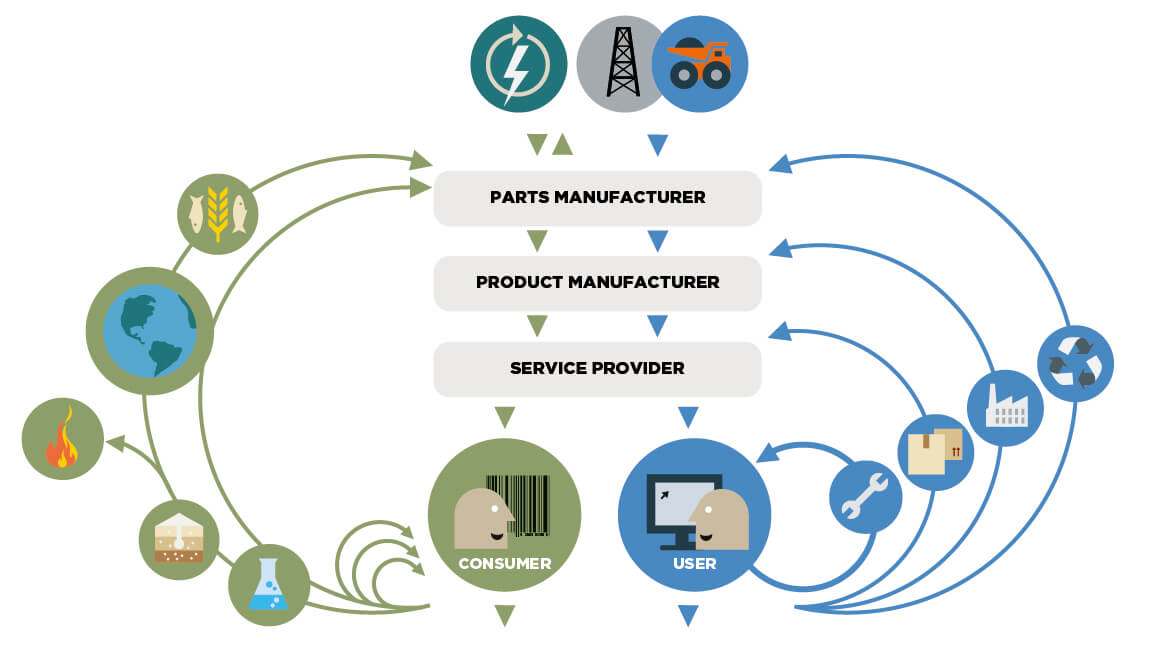
The butterfly diagram: visualising the circular economy
The 'butterfly diagram' shows the continuous flow of materials in a circular economy.

Explaining the circular economy: re-thinking progress
Watch our beginner's guide to understanding how a circular economy works.

Circular economy key ideas
Get up to speed with the fundamentals of the circular economy with these content pills or dive deep...
Circular economy principles
A circular economy is based on three principles, all driven by design.

The first principle of the circular economy is to eliminate waste and pollution....

Circulate products and materials
The second principle of the circular economy is to circulate products and materials at their...

By shifting our economy from linear to circular, we shift the focus from extraction to...
Circular economy examples
See the circular economy in action with these case studies from brands, businesses and policy makers.
Natura Brazil
Working with nature to make food last longer
Apeel is a company that has come up with an innovative way to eliminate single-use shrink wrap plastic packaging on fresh fruit and veg, while at the same time tackling food waste.
Apeel is a layer of edible, plant-based coating applied to fresh products that mimics and enhances the natural defences of fruit and vegetables. This slows down the two main things that cause spoilage – water loss and oxidation.

Case studies
Our curated collection of case studies presents circular economy success stories from around the...

Ellen MacArthur Foundation FILMS
In this series of circular economy events, experts discuss how circular economy solutions are...

Podcast: What is the circular economy?
Ellen MacArthur discusses a range of topics in a conversation about the circular economy.

Circular Economy: The Big Idea
Delve into the concepts of the circular economy to understand its origin, design, and importance...

Circular economy courses
If you want to deepen your knowledge of the circular economy, learn how to stay ahead of the game...
Video series: What is the circular economy?

Building a Regenerative, Restorative Economy
An Introduction to the Ellen MacArthur Foundation
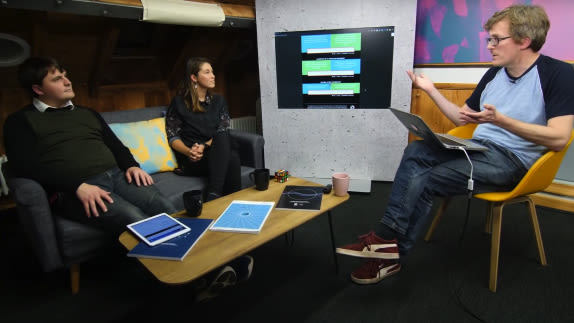
Basics of a circular economy
Our team discuss what the circular economy means to them.
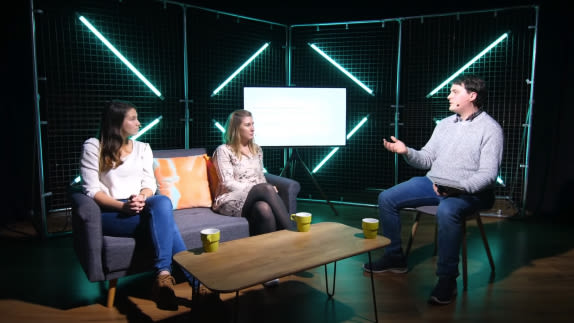
Discussing Circular Economy and What It Means
In this live conversation, members of the Ellen MacArthur Foundation team will discuss and debate...

What If We Don’t Buy Products and We Buy Service? Circular Economy Explained
With the price of resources and energy becoming increasingly volatile, can today's linear economy...
Explore the circular economy by topic

Biodiversity
Biodiversity and the circular economy
This topic area examines how the circular economy can help shape a nature-positive future.
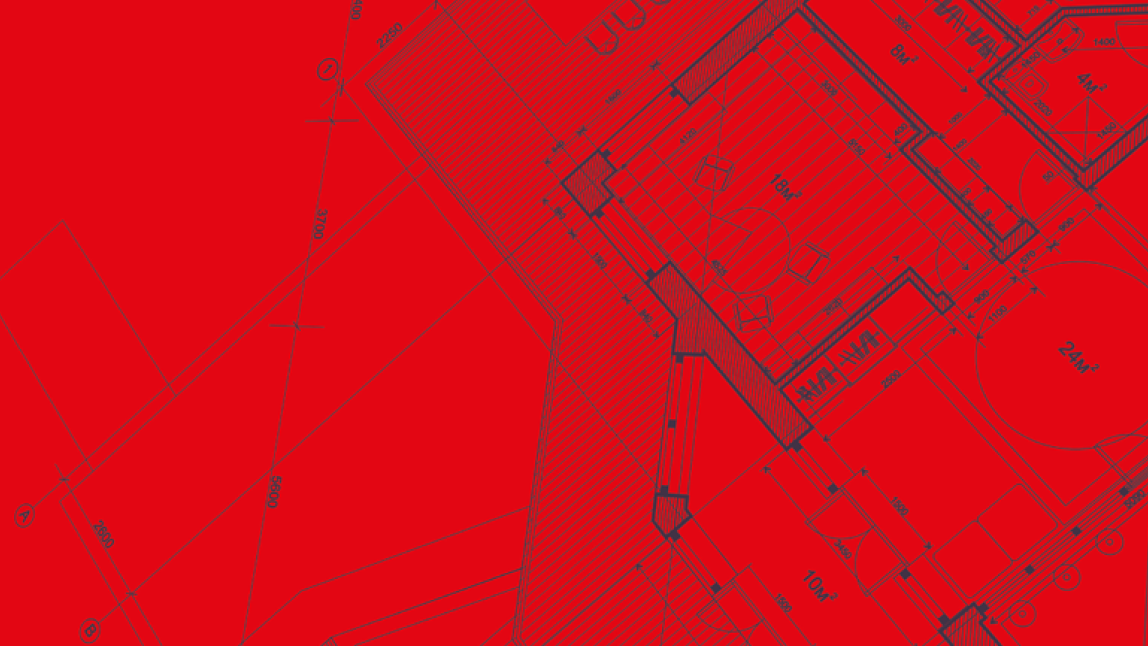
Built Environment
Built environment and the circular economy
In a circular economy our built environment can be a force for good

Cities and the circular economy
This topic area looks at the role cities play in the transition to a circular economy.

Design and the circular economy
Design is a force for change. From innovative products or disruptive business models to entire...

Climate and the circular economy
This topic area looks at how fixing the economy can help fix climate change.

Fashion and the circular economy
This topic area explores how the circular economy works for the fashion industry.

Finance and the circular economy
This topic area looks at the role of the financial sector in the shift to a circular economy.

Food and the circular economy
This topic area shows how moving to a circular economy for food will help people and nature thrive.

Plastics and the circular economy
This topic area shows how the circular economy can help keep plastic in the economy and out of the...

Government and policy for a circular economy
The circular economy provides a framework which allows governments and cities to realise many of...
Education and learning towards a circular economy
We support circular economy learning across a growing global community of schools, colleges and...

Business and the circular economy
A circular economy transformation will empower us with the tools to tackle global challenges, and...
News and updates from The Ellen MacArthur Foundation
The Ellen MacArthur Foundation works to accelerate the transition to a circular economy. We develop and promote the idea of a circular economy, and work with business, academia, policymakers, and institutions to mobilise systems solutions at scale, globally.
Charity Registration No.: 1130306
OSCR Registration No.: SC043120
Company No.: 6897785
Ellen MacArthur Foundation ANBI RSIN nummer: 8257 45 925
- Link to EMF LinkedIn page. Opens in a new tab.
- Link to EMF Twitter page. Opens in a new tab.
- Link to EMF YouTube page. Opens in a new tab.
- Link to EMF Instagram page. Opens in a new tab.
- Link to EMF Medium page. Opens in a new tab.
- Link to EMF TikTok page. Opens in a new tab.
- Link to EMF threads page. Opens in a new tab.
The work of the Ellen MacArthur Foundation is supported by our Strategic Partners and Partners.
- Link to EMF Facebook page. Opens in a new tab.
New CAS Class Teaches the History of Empires Through Fashion and Beauty
Students design and construct custom outfits based on historical case studies.

Jilene Chua’s Fashion and Beauty Under War and Empire is a course on how clothing and makeup provided insights into war and empire in the 20th century.
Sam Thomas (COM’24)
Jackie ricciardi.
A skirt made of newspaper. A blonde wig with brown roots. A headband made of crocheted “plarn” (yarn made of repurposed plastic bags). A pair of army green pants with extra pockets sewn around the ankles.
In lieu of a traditional exam, Jilene Chua , a College of Arts & Sciences assistant professor of history, assigned her students a different kind of final for their Fashion and Beauty Under War and Empire class: designing and constructing an entire outfit. The course, which wrapped earlier this month, spans the time periods from settler colonialism in the 1800s to the modern day and sets out to examine how clothing and makeup can provide insights into war and empire in the 20th century.
During the final two meetings of the class, groups presented their creations, accompanied by historical case studies they wrote reflecting on the symbolism of each piece. While some students had sewing experience, others were crafting outfits for the first time.
Chua, who came to BU this year, says she designed the Fashion and Beauty Under War and Empire class as a way to unite her research interests of history, fashion, and empire. “I wanted to figure out a way to have students learn about [this history], but in a way that wasn’t just constant violence,” she says. “Sometimes, histories of empires can be really dark and involve a lot of brutal things, so I wanted the students to think about how unexpected things like clothing, fashion, and beauty can be ways of analyzing this form of power.”
Sometimes, histories of empires can be really dark and involve a lot of brutal things, so I wanted the students to think about how unexpected things like clothing, fashion, and beauty can be ways of analyzing this form of power. Jilene Chua
Chua says the students in the class—which attracted different majors and class years—made connections she hadn’t even considered. For example, one class discussion on the prevalence of camouflage in fashion turned into an analysis of military recruitment—specifically, how it affected students during their high school experience.
In a presentation titled “Sustainability & Empire Through Time,” students investigated how different populations utilized resources readily available around them for clothing. For example, one student created a crocheted wrap to reflect how some Native American tribes used the fur of Churro sheep for clothing since it was a by-product of a food source. Another student made a shirt and attached a Kirkland jasmine rice bag, representing how people repurposed food sacks during the Great Depression.
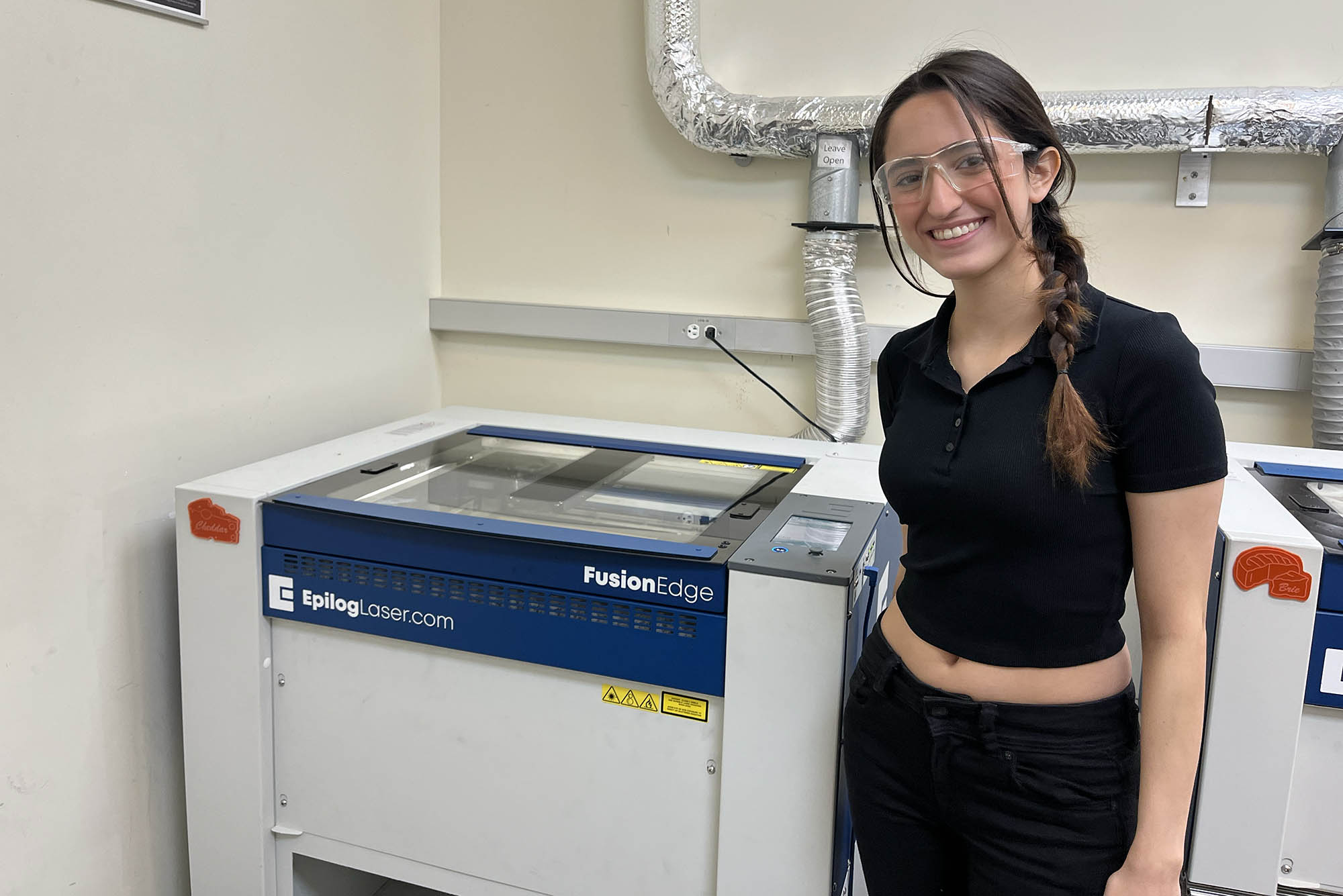
In another presentation, titled “Combat Couture: The American Culture of War,” students examined how fashion in the United States is based on a military aesthetic. They discussed the Bikini Atoll , a coral reef in the Pacific Ocean that the US government used as a nuclear testing site and how it displaced and harmed its inhabitants. The bikini swimsuit was introduced and named just four days after the testing. Now, when someone says “bikini,” it conjures images of summer days and swimming rather than nuclear waste.
“It started to make me think about how I didn’t have that on my syllabus, so I changed it to adapt,” Chua said. “It made sense to add because they have all these experiences with militarism in their own lives that they’re bringing in.”
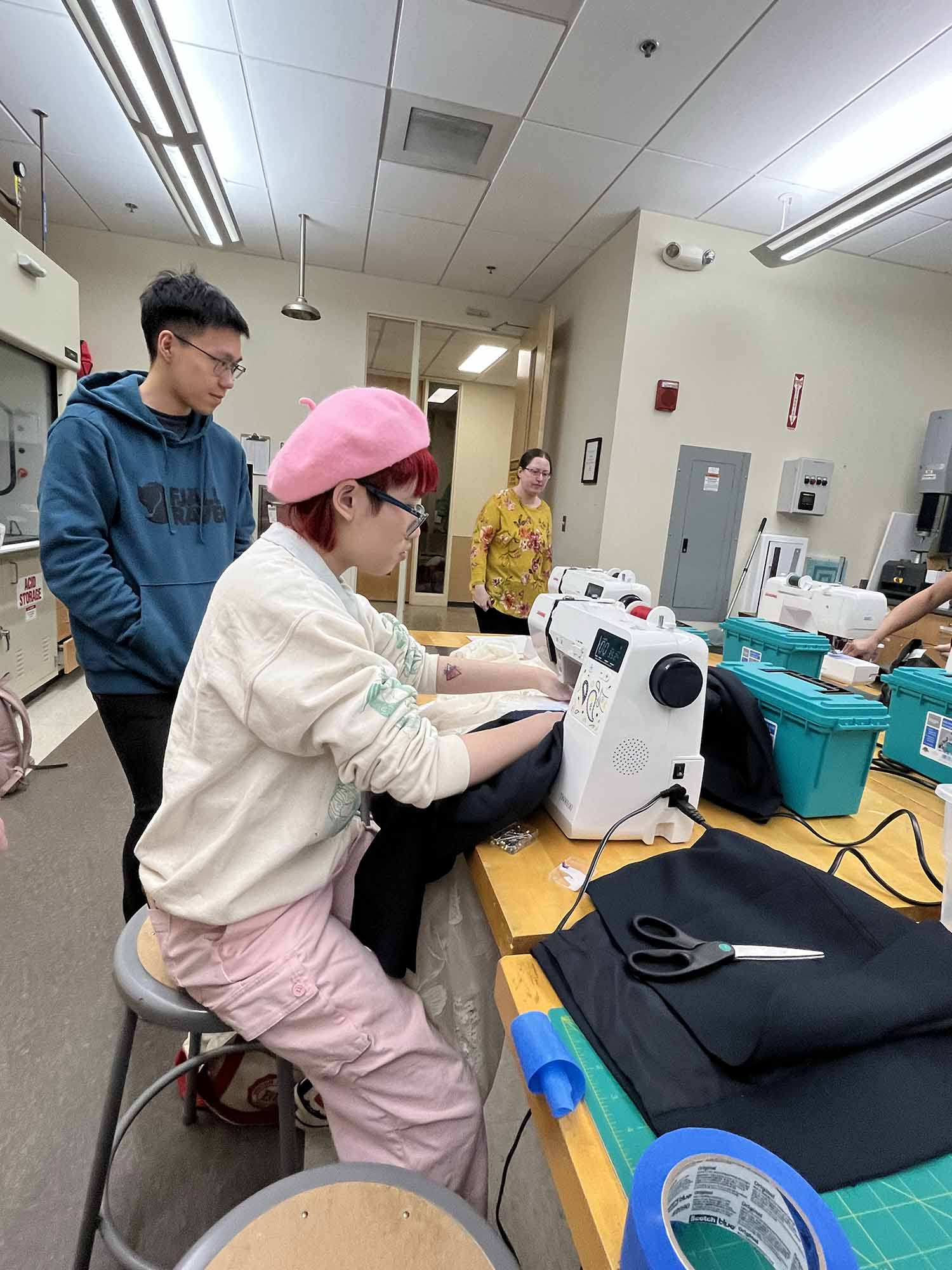
During the presentation, one student displayed a fuzzy green jacket with a camo pattern with “Are you registered for the draft?” and only a “Yes” checkbox, painted on the back. This, the student explained, was meant to represent how the draft was not optional, as well as how “fashion can reframe ugly parts of an empire into something soft and fuzzy.”
Reflecting on the course, Kal Hawley (CAS’27) says they were excited to create outfits with the added historical context from the course. Their outfit included a blazer with sewn lace hanging from about waist level, a commentary on softness—that is, not being afraid of being vulnerable or perceived as weak.
Among other topics in the course are the commodification of human products such as hair, skincare during chemical warfare, and profit as a connection between war and beauty.
Throughout the semester, Chua encouraged students to engage in sustainable practices. The class went together to Goodwill to pick out raw materials and clothing items and they discussed the environmental impacts of the fashion industry—for example, 87 percent of garments made each year end up in a landfill. The material they thrifted or recycled was then used to construct their final outfits.
Students were able to use BU’s Engineering Product Innovation Center (EPIC), right on the Charles River Campus, when crafting their clothes. EPIC spans 15,000 square feet and offers students access to a variety of engineering and manufacturing tools, such as laser cutters, welding equipment, drill presses, sewing machines, and more.
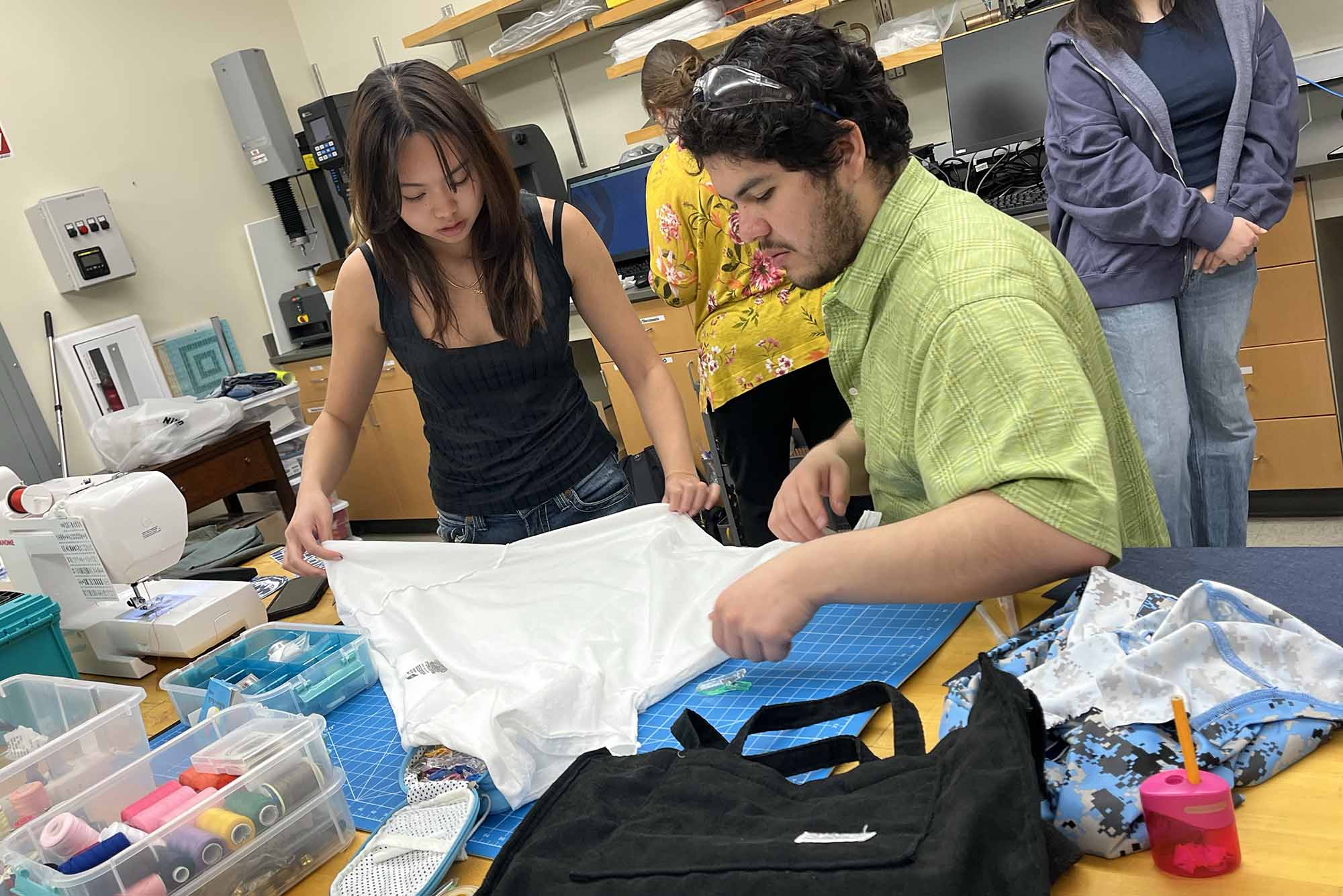
Ivan Perez (CAS’24) had no experience making clothes and had no background in fashion before enrolling. He says he took the class as a creative outlet and because he wanted “to see how and what a class like this could offer.” His enrollment in the course was a “happy accident,” he says.
“Aside, of course, from the material covered throughout the semester, the class really helped me express myself creatively through an unfamiliar yet incredibly cool medium,” Perez says. “It certainly was a unique experience, and an obscure class that made the semester very memorable. It is something quite niche that BU offers. I was just fortunate enough to stumble upon a new diamond in the rough.”
Although the class focuses specifically on fashion and beauty, Chua says she hopes this kind of critical societal analysis carries over to other parts of her students’ lives.
“I think they’re already starting to make connections to how this is a culture of militarism all around us even today,” she says. “But with these big topics like war and empire, students can see how they also appear in everyday life, not just through clothing and beauty. We are still living this culture out, right now.”
Explore Related Topics:
- College of Arts & Sciences
- Share this story
- 0 Comments Add
Sam Thomas (COM’24) Profile
Staff photojournalist

Jackie Ricciardi is a staff photojournalist at BU Today and Bostonia magazine. She has worked as a staff photographer at newspapers that include the Augusta Chronicle in Augusta, Ga., and at Seacoast Media Group in Portsmouth, N.H., where she was twice named New Hampshire Press Photographer of the Year. Profile
Comments & Discussion
Boston University moderates comments to facilitate an informed, substantive, civil conversation. Abusive, profane, self-promotional, misleading, incoherent or off-topic comments will be rejected. Moderators are staffed during regular business hours (EST) and can only accept comments written in English. Statistics or facts must include a citation or a link to the citation.
Post a comment. Cancel reply
Your email address will not be published. Required fields are marked *
Latest from BU Today
Capture the moment: use #bu2024 to get featured on the jumbotron at commencement, for these identical triplets, bu was a chance to stand apart as individuals, seniors share some of their favorite memories of their time at bu, for this bu employee, commencement will be a family affair, seniors have some advice for their first year selves, bu softball claims patriot league title, begins ncaa tournament play friday, kahn award will carry theater arts major madeline riddick-seals back to alabama, commencement 2024: what you need to know, pov: decision to reclassify marijuana as a less dangerous drug is long overdue, esl classes offered to bu dining services workers, sargent senior gives back to his native nairobi—through sports, providing better support to disabled survivors of sexual assault, class of 2024: songs that remind you of your last four years at boston university, cloud computing platform cloudweaver wins at spring 2024 spark demo day, a birder’s guide to boston university, boston teens pitch biotech concepts to bu “investors” at biological design center’s stem pathways event, the weekender: may 9 to 12, dean sandro galea leaving bu’s school of public health for washu opportunity, meet the 2024 john s. perkins award winners.
In the tech world and beyond, new 5G applications are being discovered every day. From driverless cars to smarter cities, farms, and even shopping experiences, the latest standard in wireless networks is poised to transform the way we interact with information, devices and each other. What better time to take a closer look at how humans are putting 5G to use to transform their world.
What is 5G?
5G (fifth-generation mobile technology is the newest standard for cellular networks. Like its predecessors, 3G, 4G and 4G LTE, 5G technology uses radio waves for data transmission. However, due to significant improvements in latency, throughput and bandwidth, 5G is capable of faster download and upload speeds than previous networks.
Since its release in 2019, 5G broadband technology has been hailed as a breakthrough technology with significant implications for both consumers and businesses. Primarily, this is due to its ability to handle large volumes of data that is generated by complex devices that use its networks.
As mobile technology has expanded over the years, the number of data users generate every day has increased exponentially. Currently, other transformational technologies like artificial intelligence (AI), the Internet of Things (IoT ) and machine learning (ML) require faster speeds to function than 3G and 4G networks offer. Enter 5G, with its lightning-fast data transfer capabilities that allow newer technologies to function in the way they were designed to.
Here are some of the biggest differences between 5G and previous wireless networks.
- Physical footprint : The transmitters that are used in 5G technology are smaller than in predecessors’ networks, allowing for discrete placement in out-of-the-way places. Furthermore, “cells”—geographical areas that all wireless networks require for connectivity—in 5G networks are smaller and require less power to run than in previous generations.
- Error rates : 5G’s adaptive Modulation and Coding Scheme (MCS), a schematic that wifi devices use to transmit data, is more powerful than ones in 3G and 4G networks. This makes 5G’s Block Error Rate (BER)—a metric of error frequency—much lower.
- Bandwidth : By using a broader spectrum of radio frequencies than previous wireless networks, 5G networks can transmit on a wider range of bandwidths. This increases the number of devices that they can support at any given time.
- Lower latency : 5G’s low latency , a measurement of the time it takes data to travel from one location to another, is a significant upgrade over previous generations. This means that routine activities like downloading a file or working in the cloud is going to be faster with a 5G connection than a connection on a different network.
Like all wireless networks, 5G networks are separated into geographical areas that are known as cells. Within each cell, wireless devices—such as smartphones, PCs, and IoT devices—connect to the internet via radio waves that are transmitted between an antenna and a base station. The technology that underpins 5G is essentially the same as in 3G and 4G networks. But due to its lower latency, 5G networks are capable of delivering faster download speeds—in some cases as high as 10 gigabits per second (Gbps).
As more and more devices are built for 5G speeds, demand for 5G connectivity is growing. Today, many popular Internet Service Providers (ISPs), such as Verizon, Google and AT&T, offer 5G networks to homes and businesses. According to Statista, more than 200 million homes and businesses have already purchased it with that number expected to at least double by 2028 (link resides outside ibm.com).
Let’s take a look at three areas of technological improvement that have made 5G so unique.
New telecom specifications
The 5G NR (New Radio) standard for cellular networks defines a new radio access technology (RAT) specification for all 5G mobile networks. The 5G rollout began in 2018 with a global initiative known as the 3rd Generation Partnership Project (3FPP). The initiative defined a new set of standards to steer the design of devices and applications for use on 5G networks.
The initiative was a success, and 5G networks grew swiftly in the ensuing years. Today, 45% of networks worldwide are 5G compatible, with that number forecasted to rise to 85% by the end of the decade according to a recent report by Ericsson (link resides outside ibm.com).
Independent virtual networks (network slicing)
On 5G networks, network operators can offer multiple independent virtual networks (in addition to public ones) on the same infrastructure. Unlike previous wireless networks, this new capability allows users to do more things remotely with greater security than ever before. For example, on a 5G network, enterprises can create use cases or business models and assign them their own independent virtual network. This dramatically improves the user experience for their employees by adding greater customizability and security.
Private networks
In addition to network slicing, creating a 5G private network can also enhance personalization and security features over those available on previous generations of wireless networks. Global businesses seeking more control and mobility for their employees increasingly turn to private 5G network architectures rather than public networks they’ve used in the past.
Now that we better understand how 5G technology works, let’s take a closer look at some of the exciting applications it’s enabling.
Autonomous vehicles
From taxi cabs to drones and beyond, 5G technology underpins most of the next-generation capabilities in autonomous vehicles. Until the 5G cellular standard came along, fully autonomous vehicles were a bit of a pipe dream due to the data transmission limitations of 3G and 4G technology. Now, 5G’s lightning-fast connection speeds have made transport systems for cars, trains and more, faster than previous generations, transforming the way systems and devices connect, communicate and collaborate.
Smart factories
5G, along with AI and ML, is poised to help factories become not only smarter but more automated, efficient, and resilient. Today, many mundane but necessary tasks that are associated with equipment repair and optimization are being turned over to machines thanks to 5G connectivity paired with AI and ML capabilities. This is one area where 5G is expected to be highly disruptive, impacting everything from fuel economy to the design of equipment lifecycles and how goods arrive at our homes.
For example, on a busy factory floor, drones and cameras that are connected to smart devices that use the IoT can help locate and transport something more efficiently than in the past and prevent theft. Not only is this better for the environment and consumers, but it also frees up employees to dedicate their time and energy to tasks that are more suited to their skill sets.
Smart cities
The idea of a hyper-connected urban environment that uses 5G network speeds to spur innovation in areas like law enforcement, waste disposal and disaster mitigation is fast becoming a reality. Some cities already use 5G-enabled sensors to track traffic patterns in real time and adjust signals, helping guide the flow of traffic, minimize congestion, and improve air quality.
In another example, 5G power grids monitor supply and demand across heavily populated areas and deploy AI and ML applications to “learn” what times energy is in high or low demand. This process has been shown to significantly impact energy conservation and waste, potentially reducing carbon emissions and helping cities reach sustainability goals.
Smart healthcare
Hospitals, doctors, and the healthcare industry as a whole already benefit from the speed and reliability of 5G networks every day. One example is the area of remote surgery that uses robotics and a high-definition live stream that is connected to the internet via a 5G network. Another is the field of mobile health, where 5G gives medical workers in the field quick access to patient data and medical history. This enables them to make smarter decisions, faster, and potentially save lives.
Lastly, as we saw during the pandemic, contact tracing and the mapping of outbreaks are critical to keeping populations safe. 5G’s ability to deliver of volumes of data swiftly and securely allows experts to make more informed decisions that have ramifications for everyone.
5G paired with new technological capabilities won’t just result in the automation of employee tasks, it will dramatically improve them and the overall employee experience . Take virtual reality (VR) and augmented reality (AR), for example. VR (digital environments that shut out the real world) and AR (digital content that augments the real world) are already used by stockroom employees, transportation drivers and many others. These employees rely on wearables that are connected to a 5G network capable of high-speed data transfer rates that improve several key capabilities, including the following:
- Live views : 5G connectivity provides live, real-time views of equipment, events, and even people. One way in which this feature is being used in professional sports is to allow broadcasters to remotely call a sporting event from outside the stadium where the event is taking place.
- Digital overlays : IoT applications in a warehouse or industrial setting allow workers that are equipped with smart glasses (or even just a smartphone) to obtain real-time insights from an application. This includes repair instructions or the name and location of a spare part.
- Drone inspections : Right now, one of the leading causes of employee injury is inspection of equipment or project sites in remote and potentially dangerous areas. Drones, which are connected via 5G networks, can safely monitor equipment and project sites and even take readings from hard-to-reach gauges.
Edge computing , a computing framework that allows computations to be done closer to data sources, is fast becoming the standard for enterprises. According to this Gartner white paper (link resides outside ibm.com), by 2025, 75% of enterprise data will be processed at the edge (compared to only 10% today). This shift saves businesses time and money and enables better control over large volumes of data. It would be impossible without the new speed standards that are generated by 5G technology.
Ultra-reliable edge computing and 5G enable the enterprise to achieve faster transmission speeds, increased control and greater security over massive volumes of data. Together, these twin technologies will help reduce latency while increasing speed, reliability and bandwidth, resulting in faster, more comprehensive data analysis and insights for businesses everywhere.
5G solutions with IBM Cloud Satellite
5G presents significant opportunities for the enterprise, but first, you need a platform that can handle its speed. IBM Cloud Satellite® lets you deploy and run apps consistently across on-premises, edge computing and public cloud environments on a 5G network. And it’s all enabled by secure and auditable communications within the IBM Cloud®.
Get the latest tech insights and expert thought leadership in your inbox.
Get our newsletters and topic updates that deliver the latest thought leadership and insights on emerging trends.
- SUGGESTED TOPICS
- The Magazine
- Newsletters
- Managing Yourself
- Managing Teams
- Work-life Balance
- The Big Idea
- Data & Visuals
- Reading Lists
- Case Selections
- HBR Learning
- Topic Feeds
- Account Settings
- Email Preferences
Research: Negotiating Is Unlikely to Jeopardize Your Job Offer
- Einav Hart,
- Julia Bear,
- Zhiying (Bella) Ren

A series of seven studies found that candidates have more power than they assume.
Job seekers worry about negotiating an offer for many reasons, including the worst-case scenario that the offer will be rescinded. Across a series of seven studies, researchers found that these fears are consistently exaggerated: Candidates think they are much more likely to jeopardize a deal than managers report they are. This fear can lead candidates to avoid negotiating altogether. The authors explore two reasons driving this fear and offer research-backed advice on how anxious candidates can approach job negotiations.
Imagine that you just received a job offer for a position you are excited about. Now what? You might consider negotiating for a higher salary, job flexibility, or other benefits , but you’re apprehensive. You can’t help thinking: What if I don’t get what I ask for? Or, in the worst-case scenario, what if the hiring manager decides to withdraw the offer?
- Einav Hart is an assistant professor of management at George Mason University’s Costello College of Business, and a visiting scholar at the Wharton School. Her research interests include conflict management, negotiations, and organizational behavior.
- Julia Bear is a professor of organizational behavior at the College of Business at Stony Brook University (SUNY). Her research interests include the influence of gender on negotiation, as well as understanding gender gaps in organizations more broadly.
- Zhiying (Bella) Ren is a doctoral student at the Wharton School of the University of Pennsylvania. Her research focuses on conversational dynamics in organizations and negotiations.
Partner Center
A .gov website belongs to an official government organization in the United States.
A lock ( ) or https:// means you've safely connected to the .gov website. Share sensitive information only on official, secure websites.
- Join the National ALS Registry
- Research Publications
A new method for estimating under-recruitment of a patient registry: a case study with the Ohio Registry of Amyotrophic Lateral Sclerosis
Meifang Li [1], Xun Shi [1], Jiang Gui [2], Chao Song [3], Angeline S. Andrew [4], Erik P. Pioro [4], Elijah W. Stommel [4], Maeve Tischbein [5] & Walter G. Bradley [6]
- Department of Geography, Dartmouth College, Hanover, NH, USA
- Department of Biomedical Data Science, Geisel School of Medicine at Dartmouth, Hanover, NH, USA
- HEOA Group, West China School of Public Health and West China Fourth Hospital, Sichuan University, Chengdu City, Sichuan Province, China
- Department of Neurology, Geisel School of Medicine, Dartmouth-Hitchcock Medical Center, Lebanon, NH, USA
- Section of ALS and Related Disorders, Cleveland Clinic, Cleveland, OH, USA
- Department of Neurology, Miller School of Medicine, University of Miami, Miami, FL, USA
Scientific Reports
This paper describes an alternative method to capture-recapture to estimate missing cases in Ohio’s ALS Registry. The team used statistical modeling and spatial adjustments to identify counties in Ohio between 2016-2018 with normal case-population relationships and from it built a methodology of identifying missing cases per county. Due to factors such as incomplete case ascertainment and the limitations inherent in capture-recapture, this paper proposes using spatial analysis as an alternative means for estimating missing cases in disease registries.
Link to Paper
Read the paper here !
National Amyotrophic Lateral Sclerosis (ALS) Registry
For everyone, public health.

IMAGES
VIDEO
COMMENTS
Case Study Topics: How to Uncover Engaging Subjects (+145 Topic Ideas) In this article, you will uncover engaging case study ideas ranging from marketing strategies, educational innovations, business challenges, and management insights to probing the depths of human behavior in the media domain.
The perception of danger in different cultures. The origins of bipolar disorder through the prism of domestic violence. Covid-19 and related anxiety cases among college students. The dangers of advertisements on children's TV networks. The negative influence of Instagram and distorted body image.
Case study examples. Case studies are proven marketing strategies in a wide variety of B2B industries. Here are just a few examples of a case study: Amazon Web Services, Inc. provides companies with cloud computing platforms and APIs on a metered, pay-as-you-go basis. This case study example illustrates the benefits Thomson Reuters experienced ...
652 Case Study Topics & Good Ideas. 18 January 2024. 5518 words. 25 min read. Case study topics delve into intricate issues within various fields, shedding light on the intricacies of real-world situations. They span multiple domains, including business, where they may explore strategic decision-making strategies, or healthcare, examining ...
Psychology Case Study Topics. Dyslexia and Cognitive Neuroscience. Intelligence vs creativity. Relation of Landscape Paintings with my art. Relation between Intelligence, Logic and Creativity. Reflective essay on pointing analysis. Essay on "Legacy of Andy Warhol". Essay on storytelling.
Revised on November 20, 2023. A case study is a detailed study of a specific subject, such as a person, group, place, event, organization, or phenomenon. Case studies are commonly used in social, educational, clinical, and business research. A case study research design usually involves qualitative methods, but quantitative methods are ...
15 Real-Life Case Study Examples. Now that you understand what a case study is, let's look at real-life case study examples. In this section, we'll explore SaaS, marketing, sales, product and business case study examples with solutions. Take note of how these companies structured their case studies and included the key elements.
Step 1: Select a case to analyze. After you have developed your statement of the problem and research question, the first step in writing a case study is to select a case that is representative of the phenomenon being investigated or that provides an outlier. For example, if a researcher wants to explore the impact of COVID-19 on the ...
Use These Three Case Study Examples for Inspiration. Captivating case studies from other businesses can provide valuable ideas for how to write a case analysis for your brand. Tips may include: Specific case study topics to cover; The tone of voice you want to use; Your case study's visual layout; Accompanying imagery to enhance your analysis
A case study research paper examines a person, place, event, condition, phenomenon, or other type of subject of analysis in order to extrapolate key themes and results that help predict future trends, illuminate previously hidden issues that can be applied to practice, and/or provide a means for understanding an important research problem with greater clarity.
Here are some case studies research topic examples involving famous companies and brands: Dunkin Donuts Case Study: The Opening of New Dunkin Donuts Locations. TiVo Case Study. Starbucks Failure in Australia Case Study. Walmart Case Study: E-commerce and Competitive Advantage. LEGO Case Study: Identification and Analysis of Strategic Issues.
Case studies tend to focus on qualitative data using methods such as interviews, observations, and analysis of primary and secondary sources (e.g., newspaper articles, photographs, official records). Sometimes a case study will also collect quantitative data. Example: Mixed methods case study. For a case study of a wind farm development in a ...
Explain what you will examine in the case study. Write an overview of the field you're researching. Make a thesis statement and sum up the results of your observation in a maximum of 2 sentences. Background. Provide background information and the most relevant facts. Isolate the issues.
This means the normal rules of design apply. Use fonts, colors, and icons to create an interesting and visually appealing case study. In this case study example, we can see how multiple fonts have been used to help differentiate between the headers and content, as well as complementary colors and eye-catching icons.
Two cases about Hertz claimed top spots in 2021's Top 40 Most Popular Case Studies. Two cases about Hertz claimed top spots in 2021's Top 40 Most Popular Case Studies ... "Glory, Glory, Man United!" a case about an English football team's IPO made a surprise move to number four. Cases on search fund boards, the future of malls, Norway's ...
A case study is an in-depth study of one person, group, or event. In a case study, nearly every aspect of the subject's life and history is analyzed to seek patterns and causes of behavior. Case studies can be used in many different fields, including psychology, medicine, education, anthropology, political science, and social work.
To save you time and effort, I have curated a list of 5 versatile case study presentation templates, each designed for specific needs and audiences. Here are some best case study presentation examples that showcase effective strategies for engaging your audience and conveying complex information clearly. 1. Lab report case study template.
A case study is a research method used to study a particular individual, group, or situation in depth. It involves analyzing and interpreting data from a variety of sources to gain insight into the subject being studied. Case studies are often used in psychology, business, and education to explore complicated problems and find solutions.
Showing results in Case Studies-based conversations for English learners of all levels. Tanya's Parenting Problems. Level: Intermediate. Type: Case Studies. Topic: Children. View Conversation. ... Explore our range of conversation topics for English based on their current level. All Levels; Beginner; Intermediate; Advanced;
a new paragraph. The case-study method usually involves the following steps: Step 1: The teacher introduces the situation and, if necessary, relevant vocabulary. Step 2: Everyone reads the case study and analyzes additional materials. The following procedure can help students analyze a case systematically:
success to master the English language in an academic setting. As a case study, this study was carried out to gain insights into the 'struggles' of the struggling English as a foreign language (EFL) learners. Ten students were selected from those with the 20th least percentile in their English language courses. Observation of and
Business. In this lesson, students discover pros and cons of the linear and circular economy and learn some new vocabulary and collocations related to the topic. They also work on a case study and come up with strategies to transform a company following a linear model into a more circular one. Unlimited Plan Show. C1 / Advanced | C2 / Proficiency.
Cambridge English Case Studies
Underpinned by a transition to renewable energy renewable energy Energy derived from resources that are not depleted on timescales relevant to the economy, i.e. not geological timescales. and materials, the circular economy circular economy A systems solution framework that tackles global challenges like climate change, biodiversity loss, waste, and pollution.
For example, a 2022 literature review on digital literacy—one component of media literacy—found forty-three English-language studies since 2001, with thirty-three of these published since 2017, when interest in the topic swelled. 11 The existence of dedicated journals and conferences is another indicator of growth in this subfield.
Boston University moderates comments to facilitate an informed, substantive, civil conversation. Abusive, profane, self-promotional, misleading, incoherent or off-topic comments will be rejected. Moderators are staffed during regular business hours (EST) and can only accept comments written in English.
In the tech world and beyond, new 5G applications are being discovered every day. From driverless cars to smarter cities, farms, and even shopping experiences, the latest standard in wireless networks is poised to transform the way we interact with information, devices and each other.
Summary. Job seekers worry about negotiating an offer for many reasons, including the worst-case scenario that the offer will be rescinded. Across a series of seven studies, researchers found that ...
Through data gathered from recruitment surveys, the study found that occupational exposure to particulate matter, volatile organic compounds, metals, pesticides, and combustion and diesel exhaust and employment in "Production Occupations" was associated with an increased ALS risk in this cohort.
Summary. This paper describes an alternative method to capture-recapture to estimate missing cases in Ohio's ALS Registry. The team used statistical modeling and spatial adjustments to identify counties in Ohio between 2016-2018 with normal case-population relationships and from it built a methodology of identifying missing cases per county.